Patterns, Sequences and Series in Mathematics
VerifiedAdded on 2022/10/12
|22
|3098
|274
AI Summary
This document explains different types of patterns, sequences and series in mathematics. It covers arithmetic, geometric, triangular, square number, cube number and Fibonacci sequences and their applications in various fields. It also explains geometric and arithmetic series with examples and formulas.
Contribute Materials
Your contribution can guide someone’s learning journey. Share your
documents today.
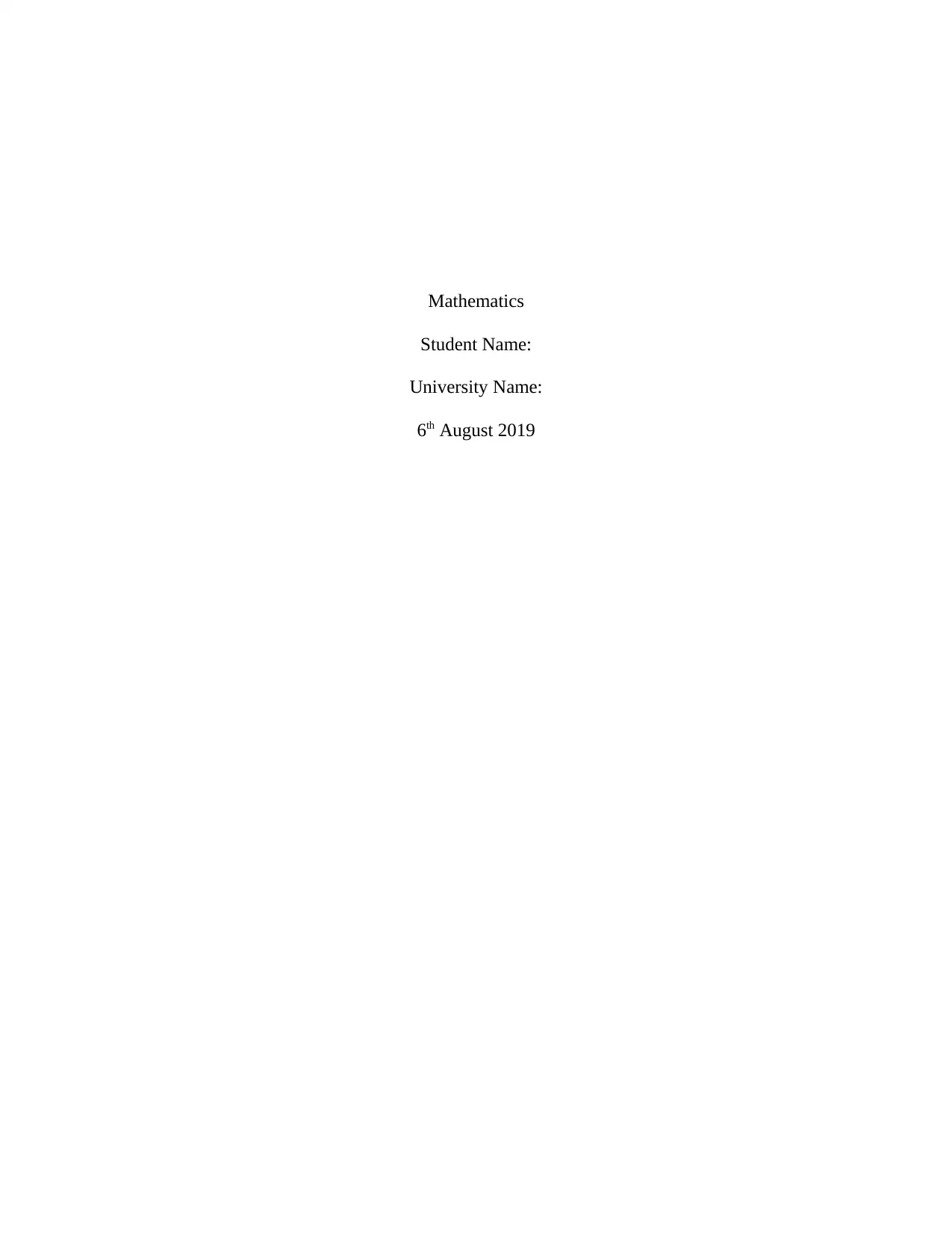
Mathematics
Student Name:
University Name:
6th August 2019
Student Name:
University Name:
6th August 2019
Secure Best Marks with AI Grader
Need help grading? Try our AI Grader for instant feedback on your assignments.
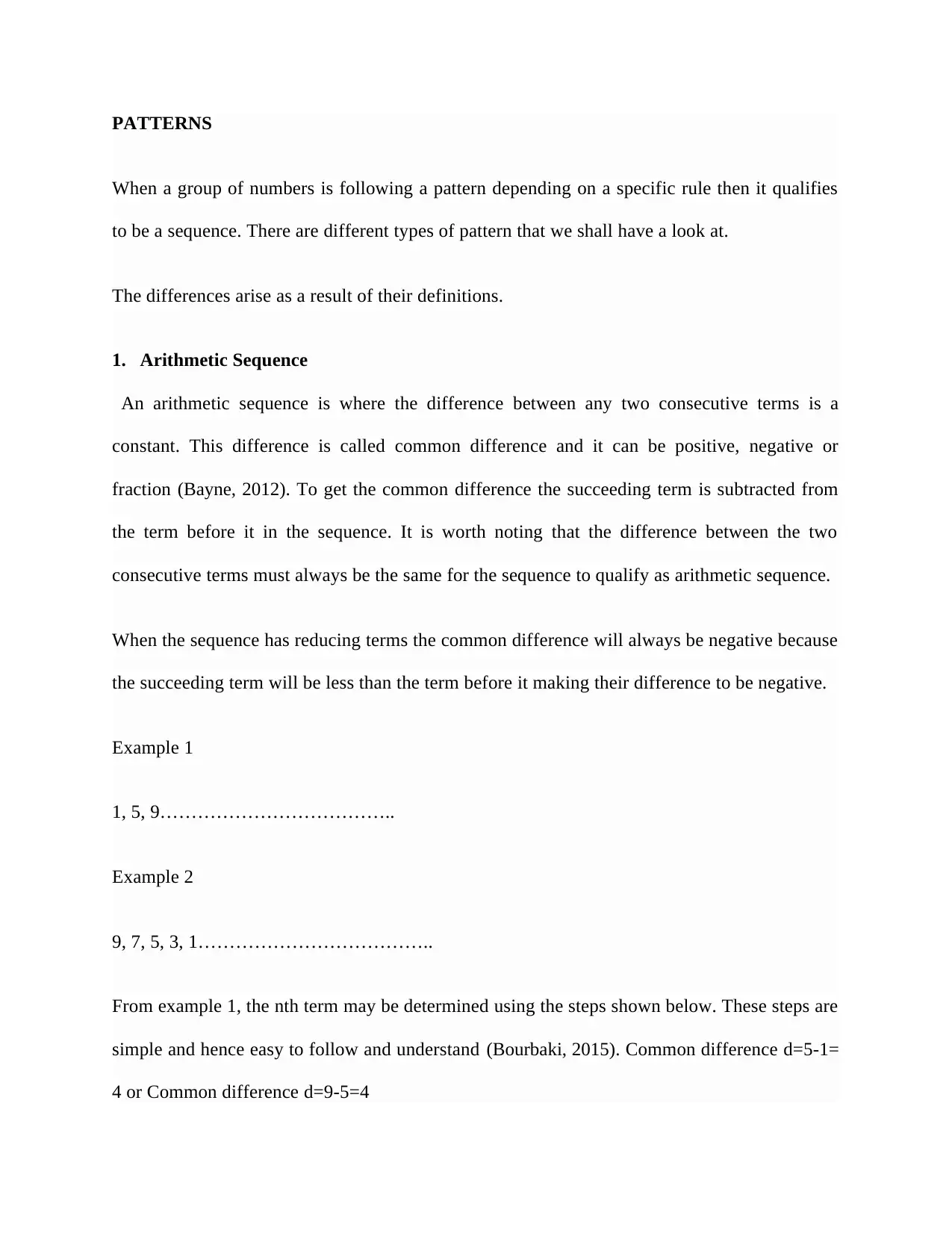
PATTERNS
When a group of numbers is following a pattern depending on a specific rule then it qualifies
to be a sequence. There are different types of pattern that we shall have a look at.
The differences arise as a result of their definitions.
1. Arithmetic Sequence
An arithmetic sequence is where the difference between any two consecutive terms is a
constant. This difference is called common difference and it can be positive, negative or
fraction (Bayne, 2012). To get the common difference the succeeding term is subtracted from
the term before it in the sequence. It is worth noting that the difference between the two
consecutive terms must always be the same for the sequence to qualify as arithmetic sequence.
When the sequence has reducing terms the common difference will always be negative because
the succeeding term will be less than the term before it making their difference to be negative.
Example 1
1, 5, 9………………………………..
Example 2
9, 7, 5, 3, 1………………………………..
From example 1, the nth term may be determined using the steps shown below. These steps are
simple and hence easy to follow and understand (Bourbaki, 2015). Common difference d=5-1=
4 or Common difference d=9-5=4
When a group of numbers is following a pattern depending on a specific rule then it qualifies
to be a sequence. There are different types of pattern that we shall have a look at.
The differences arise as a result of their definitions.
1. Arithmetic Sequence
An arithmetic sequence is where the difference between any two consecutive terms is a
constant. This difference is called common difference and it can be positive, negative or
fraction (Bayne, 2012). To get the common difference the succeeding term is subtracted from
the term before it in the sequence. It is worth noting that the difference between the two
consecutive terms must always be the same for the sequence to qualify as arithmetic sequence.
When the sequence has reducing terms the common difference will always be negative because
the succeeding term will be less than the term before it making their difference to be negative.
Example 1
1, 5, 9………………………………..
Example 2
9, 7, 5, 3, 1………………………………..
From example 1, the nth term may be determined using the steps shown below. These steps are
simple and hence easy to follow and understand (Bourbaki, 2015). Common difference d=5-1=
4 or Common difference d=9-5=4
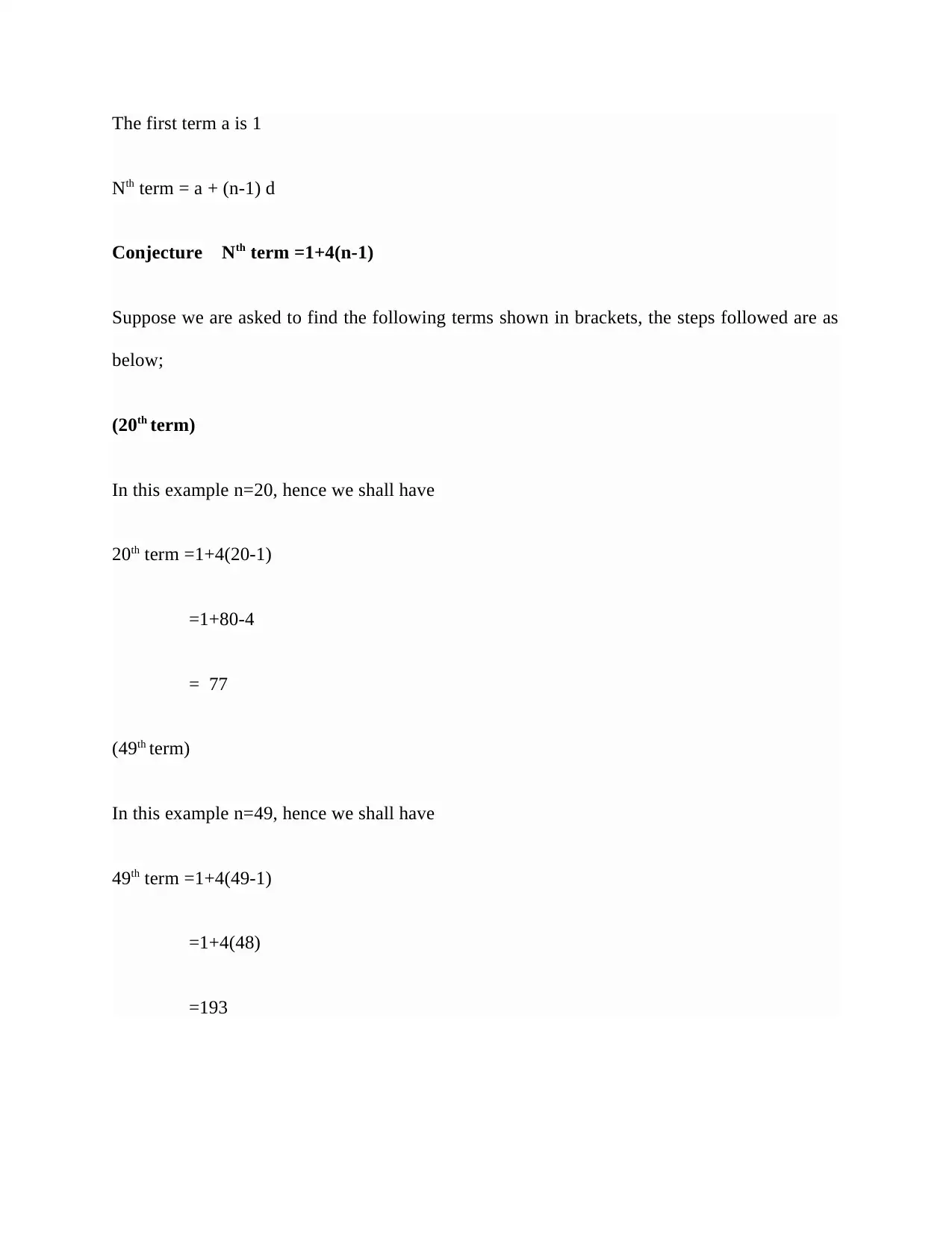
The first term a is 1
Nth term = a + (n-1) d
Conjecture Nth term =1+4(n-1)
Suppose we are asked to find the following terms shown in brackets, the steps followed are as
below;
(20th term)
In this example n=20, hence we shall have
20th term =1+4(20-1)
=1+80-4
= 77
(49th term)
In this example n=49, hence we shall have
49th term =1+4(49-1)
=1+4(48)
=193
Nth term = a + (n-1) d
Conjecture Nth term =1+4(n-1)
Suppose we are asked to find the following terms shown in brackets, the steps followed are as
below;
(20th term)
In this example n=20, hence we shall have
20th term =1+4(20-1)
=1+80-4
= 77
(49th term)
In this example n=49, hence we shall have
49th term =1+4(49-1)
=1+4(48)
=193
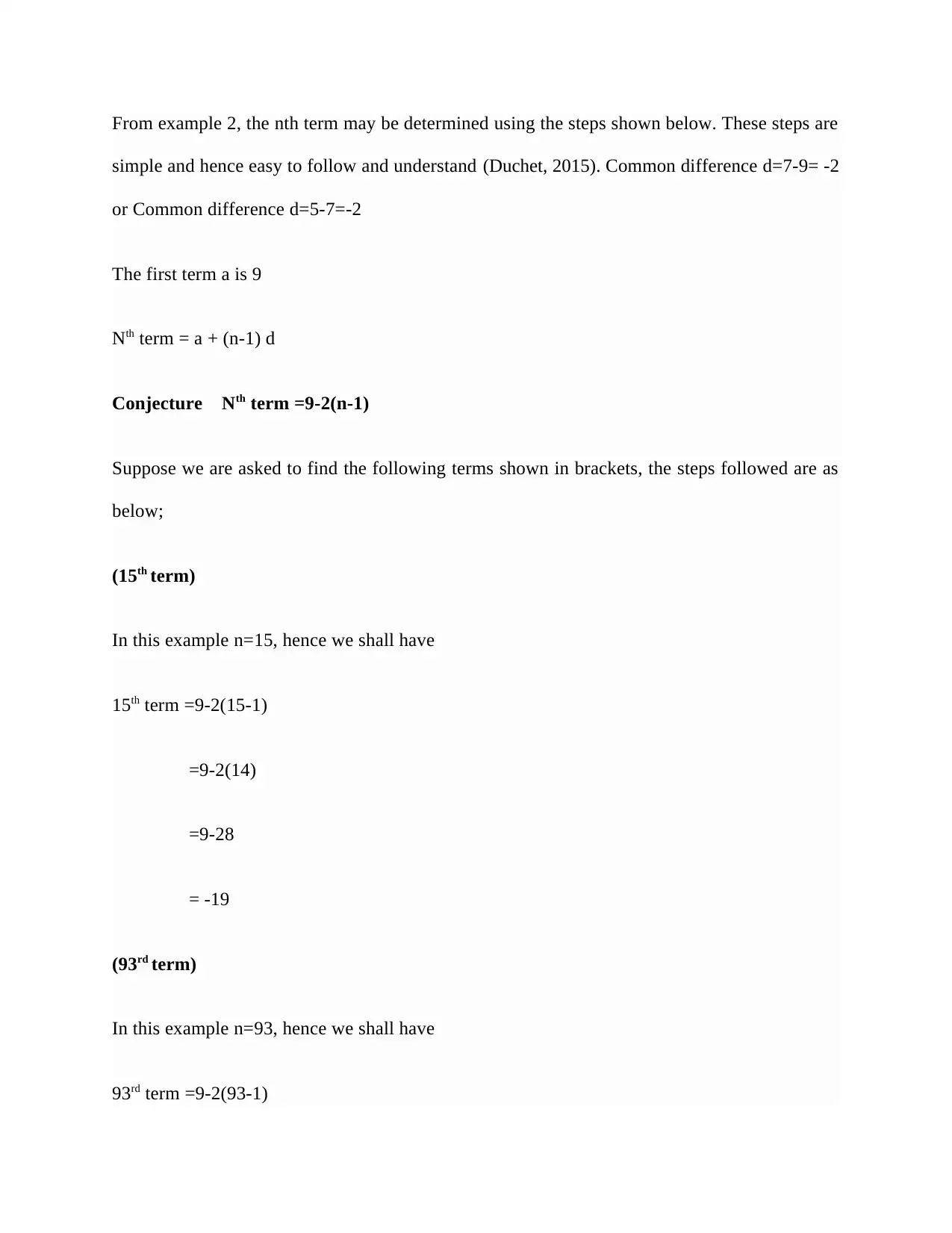
From example 2, the nth term may be determined using the steps shown below. These steps are
simple and hence easy to follow and understand (Duchet, 2015). Common difference d=7-9= -2
or Common difference d=5-7=-2
The first term a is 9
Nth term = a + (n-1) d
Conjecture Nth term =9-2(n-1)
Suppose we are asked to find the following terms shown in brackets, the steps followed are as
below;
(15th term)
In this example n=15, hence we shall have
15th term =9-2(15-1)
=9-2(14)
=9-28
= -19
(93rd term)
In this example n=93, hence we shall have
93rd term =9-2(93-1)
simple and hence easy to follow and understand (Duchet, 2015). Common difference d=7-9= -2
or Common difference d=5-7=-2
The first term a is 9
Nth term = a + (n-1) d
Conjecture Nth term =9-2(n-1)
Suppose we are asked to find the following terms shown in brackets, the steps followed are as
below;
(15th term)
In this example n=15, hence we shall have
15th term =9-2(15-1)
=9-2(14)
=9-28
= -19
(93rd term)
In this example n=93, hence we shall have
93rd term =9-2(93-1)
Secure Best Marks with AI Grader
Need help grading? Try our AI Grader for instant feedback on your assignments.
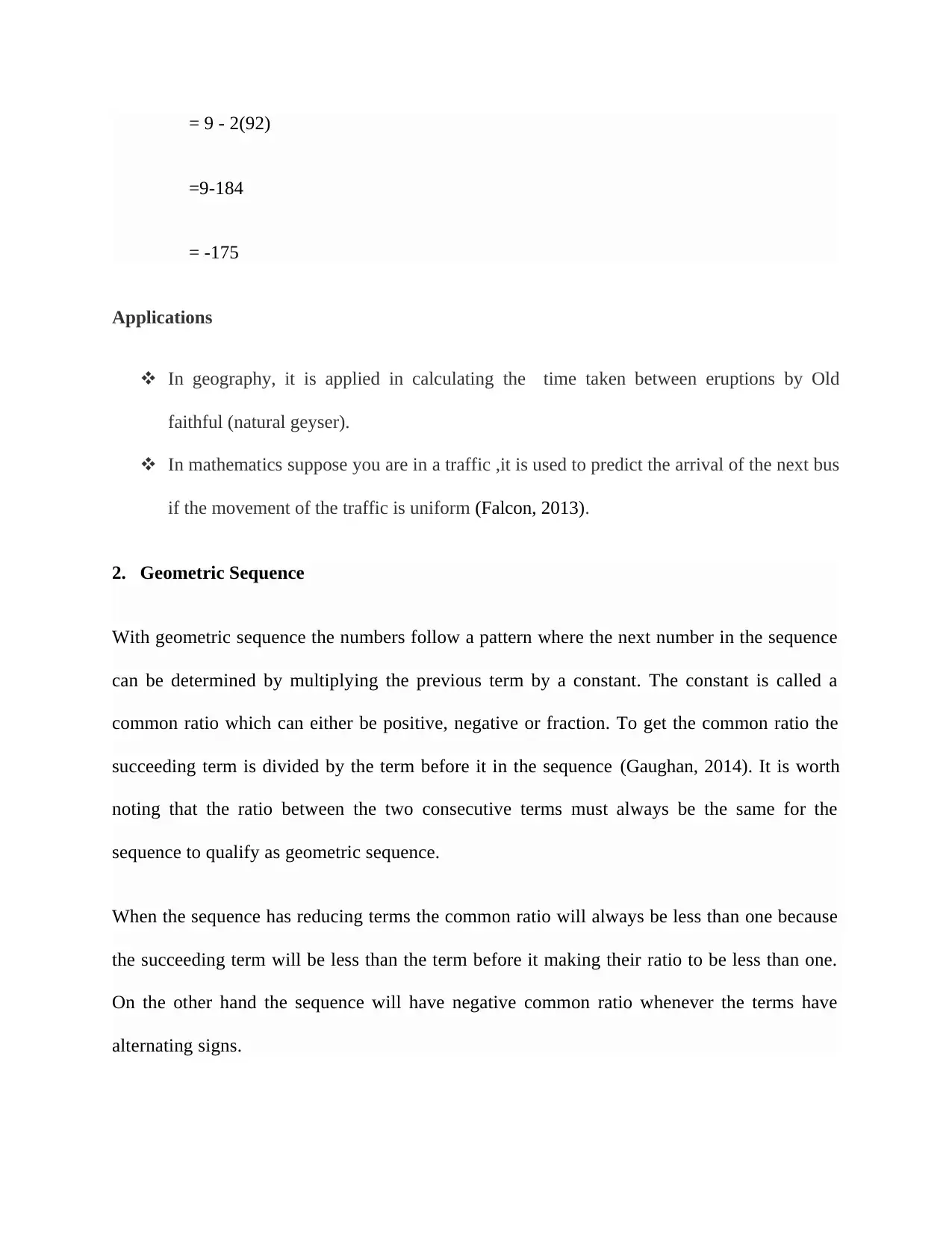
= 9 - 2(92)
=9-184
= -175
Applications
In geography, it is applied in calculating the time taken between eruptions by Old
faithful (natural geyser).
In mathematics suppose you are in a traffic ,it is used to predict the arrival of the next bus
if the movement of the traffic is uniform (Falcon, 2013).
2. Geometric Sequence
With geometric sequence the numbers follow a pattern where the next number in the sequence
can be determined by multiplying the previous term by a constant. The constant is called a
common ratio which can either be positive, negative or fraction. To get the common ratio the
succeeding term is divided by the term before it in the sequence (Gaughan, 2014). It is worth
noting that the ratio between the two consecutive terms must always be the same for the
sequence to qualify as geometric sequence.
When the sequence has reducing terms the common ratio will always be less than one because
the succeeding term will be less than the term before it making their ratio to be less than one.
On the other hand the sequence will have negative common ratio whenever the terms have
alternating signs.
=9-184
= -175
Applications
In geography, it is applied in calculating the time taken between eruptions by Old
faithful (natural geyser).
In mathematics suppose you are in a traffic ,it is used to predict the arrival of the next bus
if the movement of the traffic is uniform (Falcon, 2013).
2. Geometric Sequence
With geometric sequence the numbers follow a pattern where the next number in the sequence
can be determined by multiplying the previous term by a constant. The constant is called a
common ratio which can either be positive, negative or fraction. To get the common ratio the
succeeding term is divided by the term before it in the sequence (Gaughan, 2014). It is worth
noting that the ratio between the two consecutive terms must always be the same for the
sequence to qualify as geometric sequence.
When the sequence has reducing terms the common ratio will always be less than one because
the succeeding term will be less than the term before it making their ratio to be less than one.
On the other hand the sequence will have negative common ratio whenever the terms have
alternating signs.
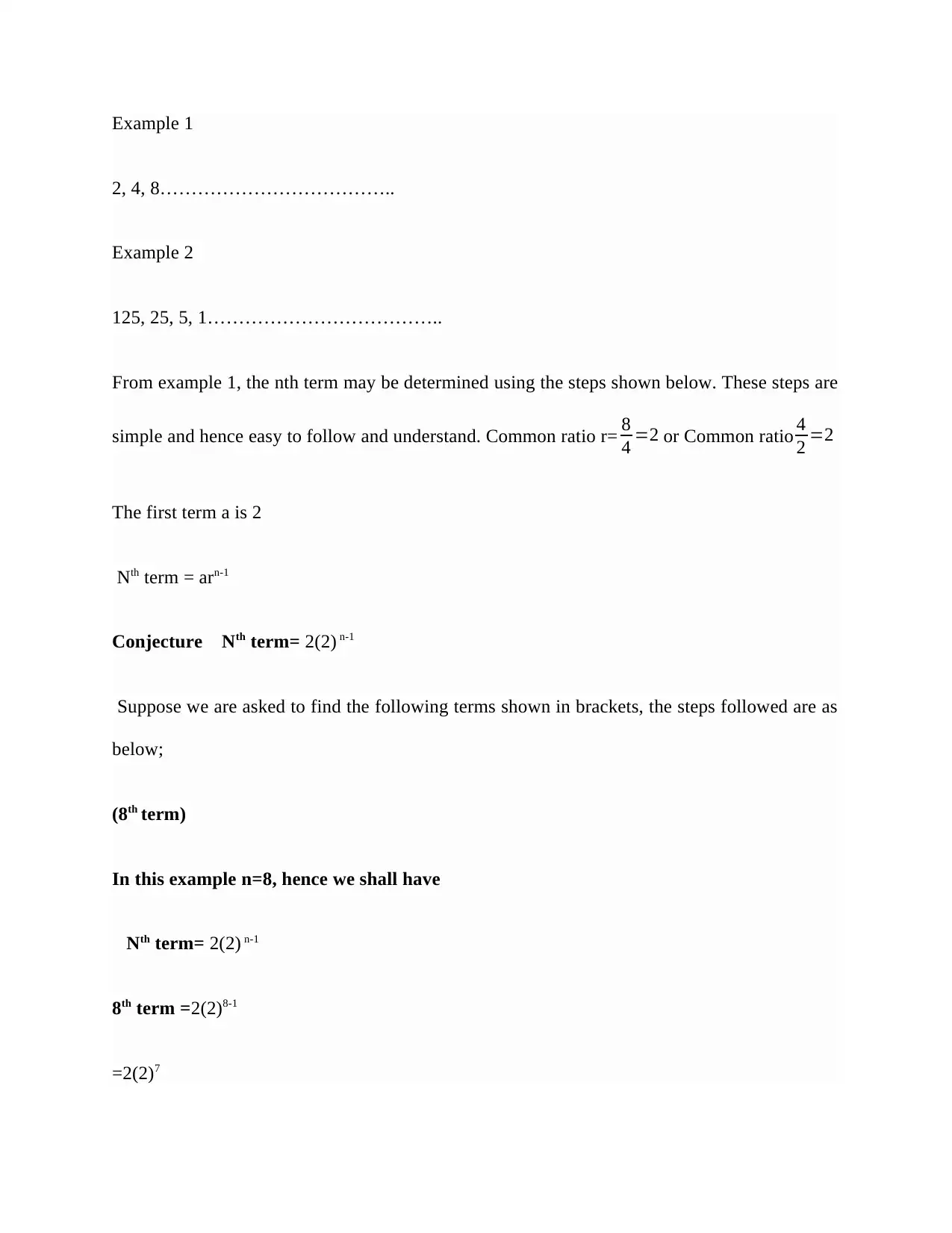
Example 1
2, 4, 8………………………………..
Example 2
125, 25, 5, 1………………………………..
From example 1, the nth term may be determined using the steps shown below. These steps are
simple and hence easy to follow and understand. Common ratio r= 8
4 =2 or Common ratio 4
2 =2
The first term a is 2
Nth term = arn-1
Conjecture Nth term= 2(2) n-1
Suppose we are asked to find the following terms shown in brackets, the steps followed are as
below;
(8th term)
In this example n=8, hence we shall have
Nth term= 2(2) n-1
8th term =2(2)8-1
=2(2)7
2, 4, 8………………………………..
Example 2
125, 25, 5, 1………………………………..
From example 1, the nth term may be determined using the steps shown below. These steps are
simple and hence easy to follow and understand. Common ratio r= 8
4 =2 or Common ratio 4
2 =2
The first term a is 2
Nth term = arn-1
Conjecture Nth term= 2(2) n-1
Suppose we are asked to find the following terms shown in brackets, the steps followed are as
below;
(8th term)
In this example n=8, hence we shall have
Nth term= 2(2) n-1
8th term =2(2)8-1
=2(2)7
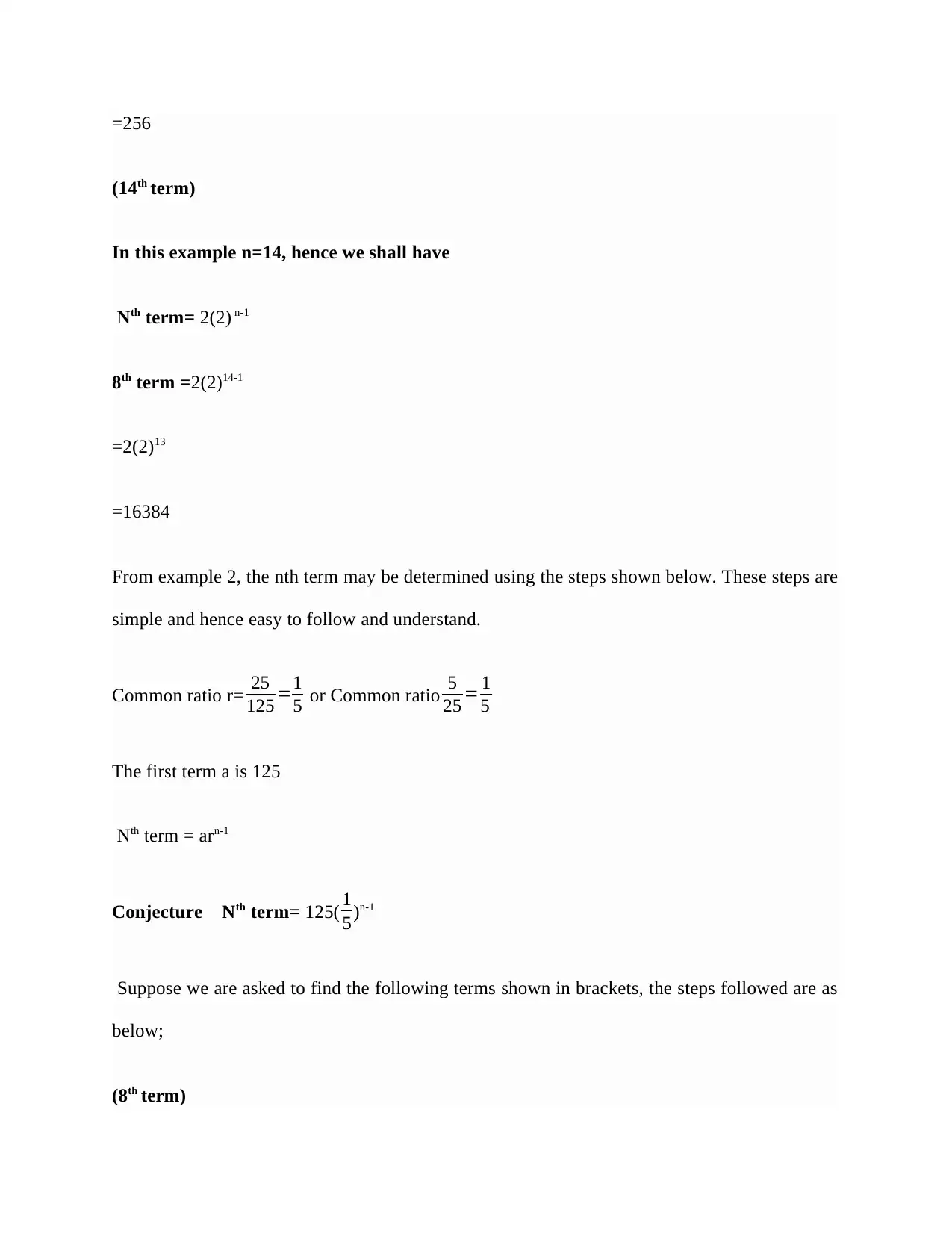
=256
(14th term)
In this example n=14, hence we shall have
Nth term= 2(2) n-1
8th term =2(2)14-1
=2(2)13
=16384
From example 2, the nth term may be determined using the steps shown below. These steps are
simple and hence easy to follow and understand.
Common ratio r= 25
125 =1
5 or Common ratio 5
25 = 1
5
The first term a is 125
Nth term = arn-1
Conjecture Nth term= 125( 1
5)n-1
Suppose we are asked to find the following terms shown in brackets, the steps followed are as
below;
(8th term)
(14th term)
In this example n=14, hence we shall have
Nth term= 2(2) n-1
8th term =2(2)14-1
=2(2)13
=16384
From example 2, the nth term may be determined using the steps shown below. These steps are
simple and hence easy to follow and understand.
Common ratio r= 25
125 =1
5 or Common ratio 5
25 = 1
5
The first term a is 125
Nth term = arn-1
Conjecture Nth term= 125( 1
5)n-1
Suppose we are asked to find the following terms shown in brackets, the steps followed are as
below;
(8th term)
Paraphrase This Document
Need a fresh take? Get an instant paraphrase of this document with our AI Paraphraser
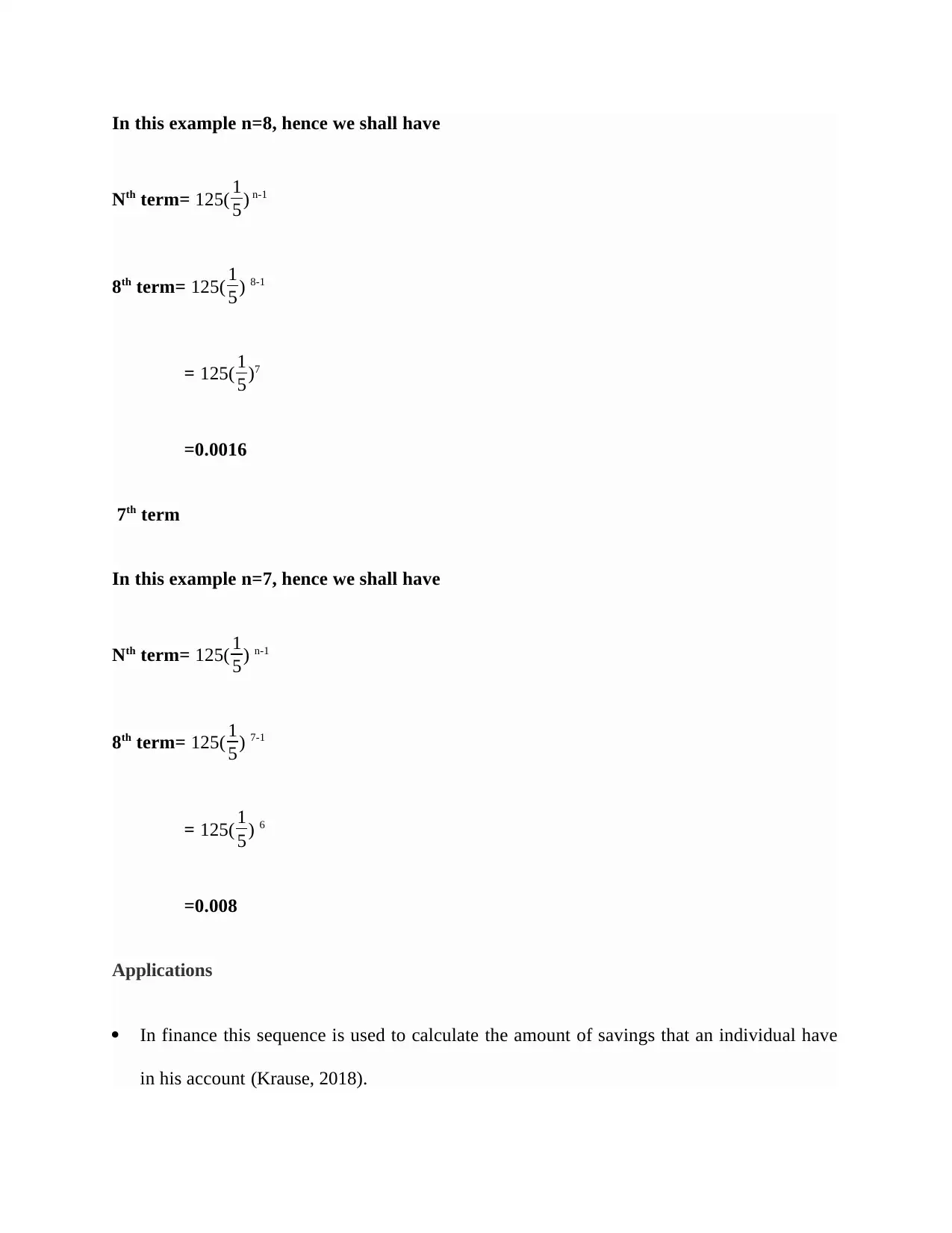
In this example n=8, hence we shall have
Nth term= 125( 1
5) n-1
8th term= 125( 1
5) 8-1
= 125( 1
5)7
=0.0016
7th term
In this example n=7, hence we shall have
Nth term= 125( 1
5) n-1
8th term= 125( 1
5) 7-1
= 125( 1
5) 6
=0.008
Applications
In finance this sequence is used to calculate the amount of savings that an individual have
in his account (Krause, 2018).
Nth term= 125( 1
5) n-1
8th term= 125( 1
5) 8-1
= 125( 1
5)7
=0.0016
7th term
In this example n=7, hence we shall have
Nth term= 125( 1
5) n-1
8th term= 125( 1
5) 7-1
= 125( 1
5) 6
=0.008
Applications
In finance this sequence is used to calculate the amount of savings that an individual have
in his account (Krause, 2018).
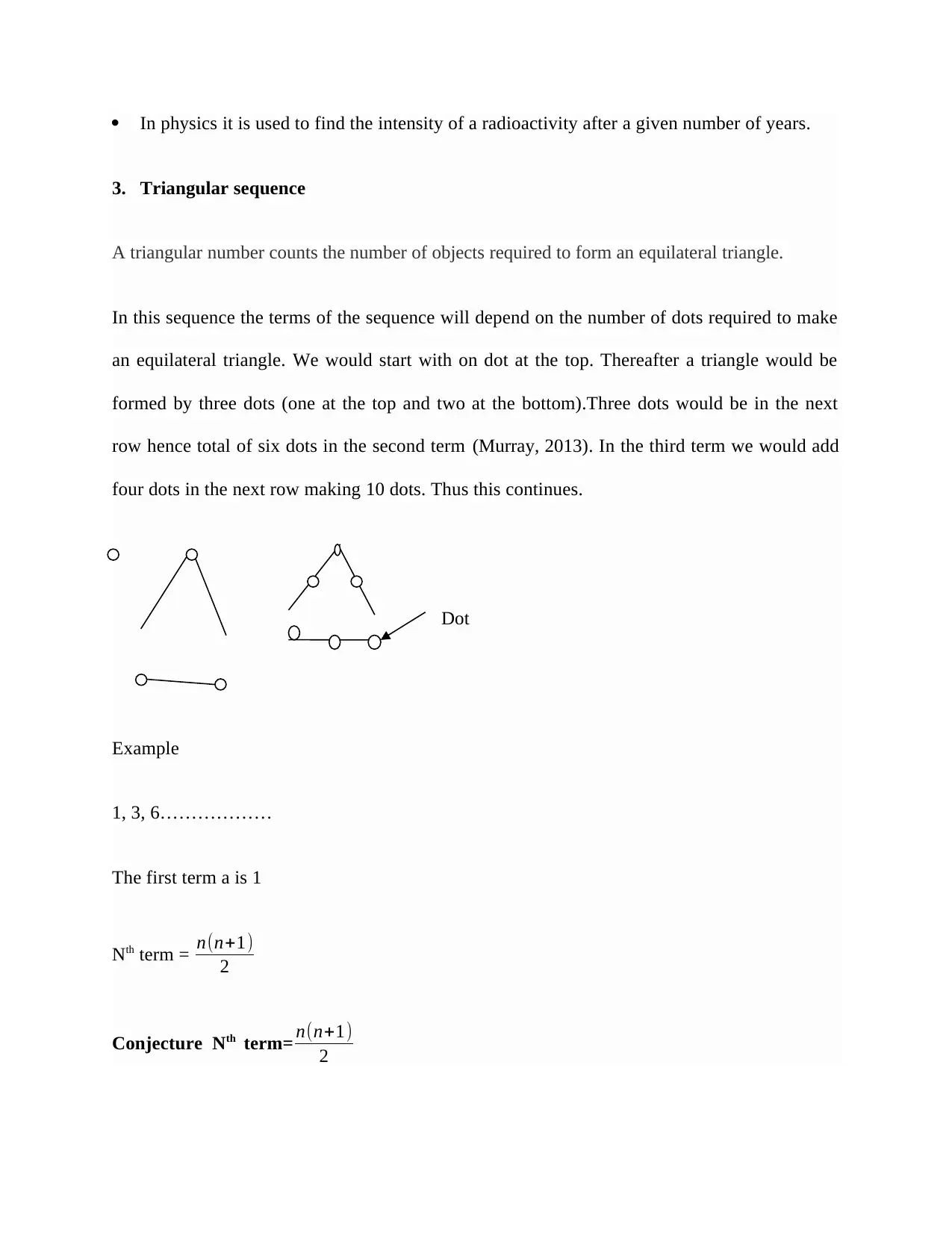
In physics it is used to find the intensity of a radioactivity after a given number of years.
3. Triangular sequence
A triangular number counts the number of objects required to form an equilateral triangle.
In this sequence the terms of the sequence will depend on the number of dots required to make
an equilateral triangle. We would start with on dot at the top. Thereafter a triangle would be
formed by three dots (one at the top and two at the bottom).Three dots would be in the next
row hence total of six dots in the second term (Murray, 2013). In the third term we would add
four dots in the next row making 10 dots. Thus this continues.
Dot
Example
1, 3, 6………………
The first term a is 1
Nth term = n(n+1)
2
Conjecture Nth term= n(n+1)
2
3. Triangular sequence
A triangular number counts the number of objects required to form an equilateral triangle.
In this sequence the terms of the sequence will depend on the number of dots required to make
an equilateral triangle. We would start with on dot at the top. Thereafter a triangle would be
formed by three dots (one at the top and two at the bottom).Three dots would be in the next
row hence total of six dots in the second term (Murray, 2013). In the third term we would add
four dots in the next row making 10 dots. Thus this continues.
Dot
Example
1, 3, 6………………
The first term a is 1
Nth term = n(n+1)
2
Conjecture Nth term= n(n+1)
2
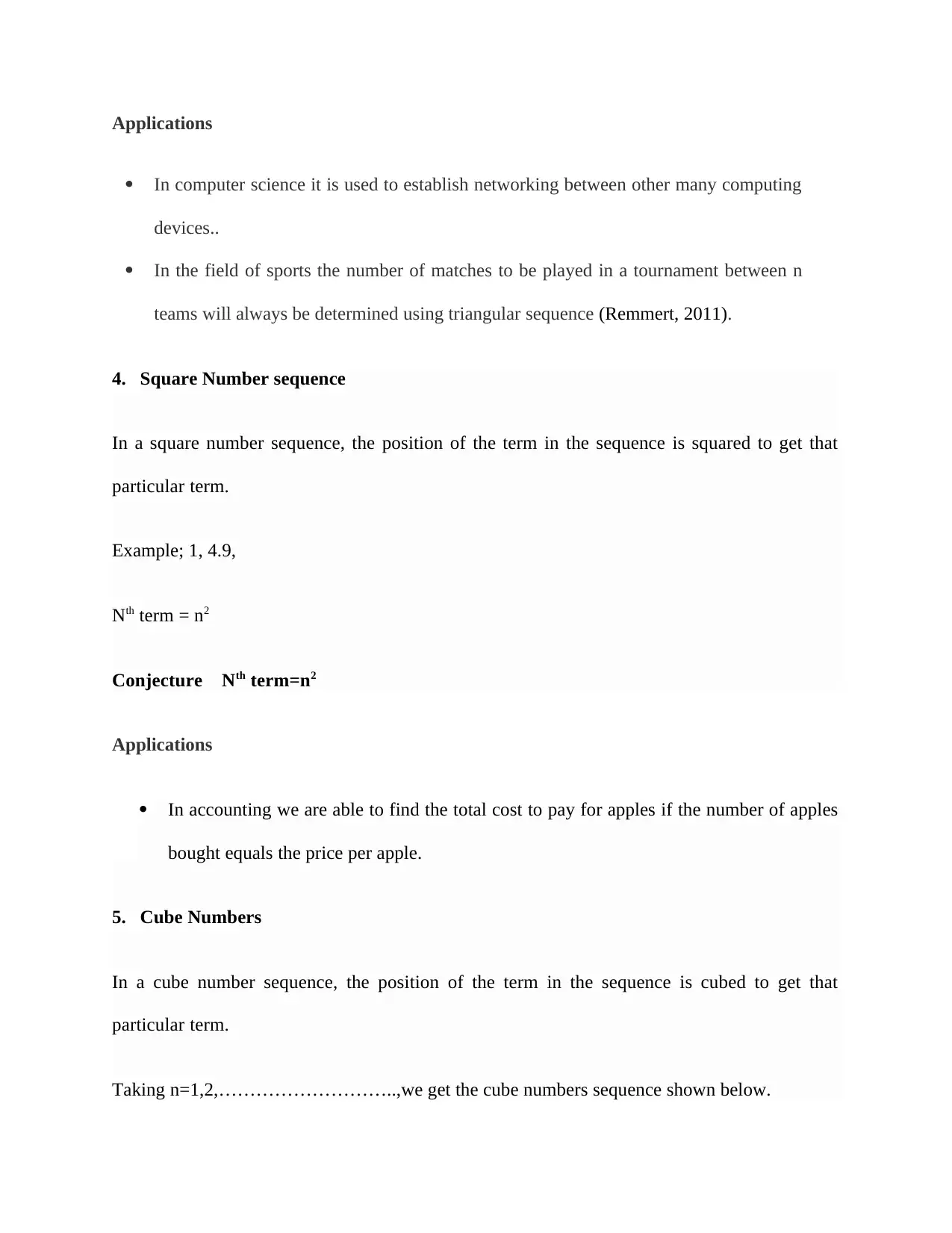
Applications
In computer science it is used to establish networking between other many computing
devices..
In the field of sports the number of matches to be played in a tournament between n
teams will always be determined using triangular sequence (Remmert, 2011).
4. Square Number sequence
In a square number sequence, the position of the term in the sequence is squared to get that
particular term.
Example; 1, 4.9,
Nth term = n2
Conjecture Nth term=n2
Applications
In accounting we are able to find the total cost to pay for apples if the number of apples
bought equals the price per apple.
5. Cube Numbers
In a cube number sequence, the position of the term in the sequence is cubed to get that
particular term.
Taking n=1,2,………………………..,we get the cube numbers sequence shown below.
In computer science it is used to establish networking between other many computing
devices..
In the field of sports the number of matches to be played in a tournament between n
teams will always be determined using triangular sequence (Remmert, 2011).
4. Square Number sequence
In a square number sequence, the position of the term in the sequence is squared to get that
particular term.
Example; 1, 4.9,
Nth term = n2
Conjecture Nth term=n2
Applications
In accounting we are able to find the total cost to pay for apples if the number of apples
bought equals the price per apple.
5. Cube Numbers
In a cube number sequence, the position of the term in the sequence is cubed to get that
particular term.
Taking n=1,2,………………………..,we get the cube numbers sequence shown below.
Secure Best Marks with AI Grader
Need help grading? Try our AI Grader for instant feedback on your assignments.
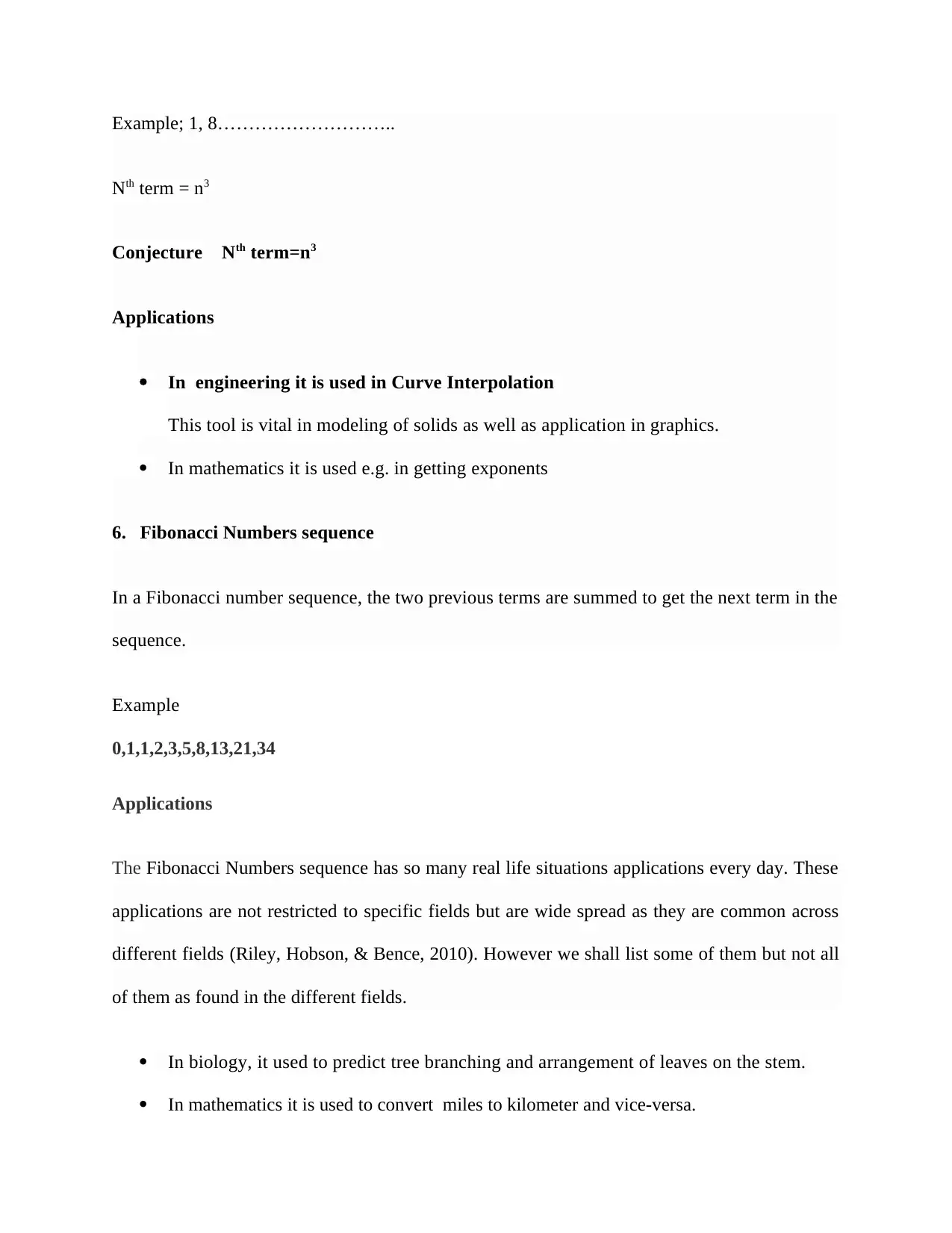
Example; 1, 8………………………..
Nth term = n3
Conjecture Nth term=n3
Applications
In engineering it is used in Curve Interpolation
This tool is vital in modeling of solids as well as application in graphics.
In mathematics it is used e.g. in getting exponents
6. Fibonacci Numbers sequence
In a Fibonacci number sequence, the two previous terms are summed to get the next term in the
sequence.
Example
0,1,1,2,3,5,8,13,21,34
Applications
The Fibonacci Numbers sequence has so many real life situations applications every day. These
applications are not restricted to specific fields but are wide spread as they are common across
different fields (Riley, Hobson, & Bence, 2010). However we shall list some of them but not all
of them as found in the different fields.
In biology, it used to predict tree branching and arrangement of leaves on the stem.
In mathematics it is used to convert miles to kilometer and vice-versa.
Nth term = n3
Conjecture Nth term=n3
Applications
In engineering it is used in Curve Interpolation
This tool is vital in modeling of solids as well as application in graphics.
In mathematics it is used e.g. in getting exponents
6. Fibonacci Numbers sequence
In a Fibonacci number sequence, the two previous terms are summed to get the next term in the
sequence.
Example
0,1,1,2,3,5,8,13,21,34
Applications
The Fibonacci Numbers sequence has so many real life situations applications every day. These
applications are not restricted to specific fields but are wide spread as they are common across
different fields (Riley, Hobson, & Bence, 2010). However we shall list some of them but not all
of them as found in the different fields.
In biology, it used to predict tree branching and arrangement of leaves on the stem.
In mathematics it is used to convert miles to kilometer and vice-versa.
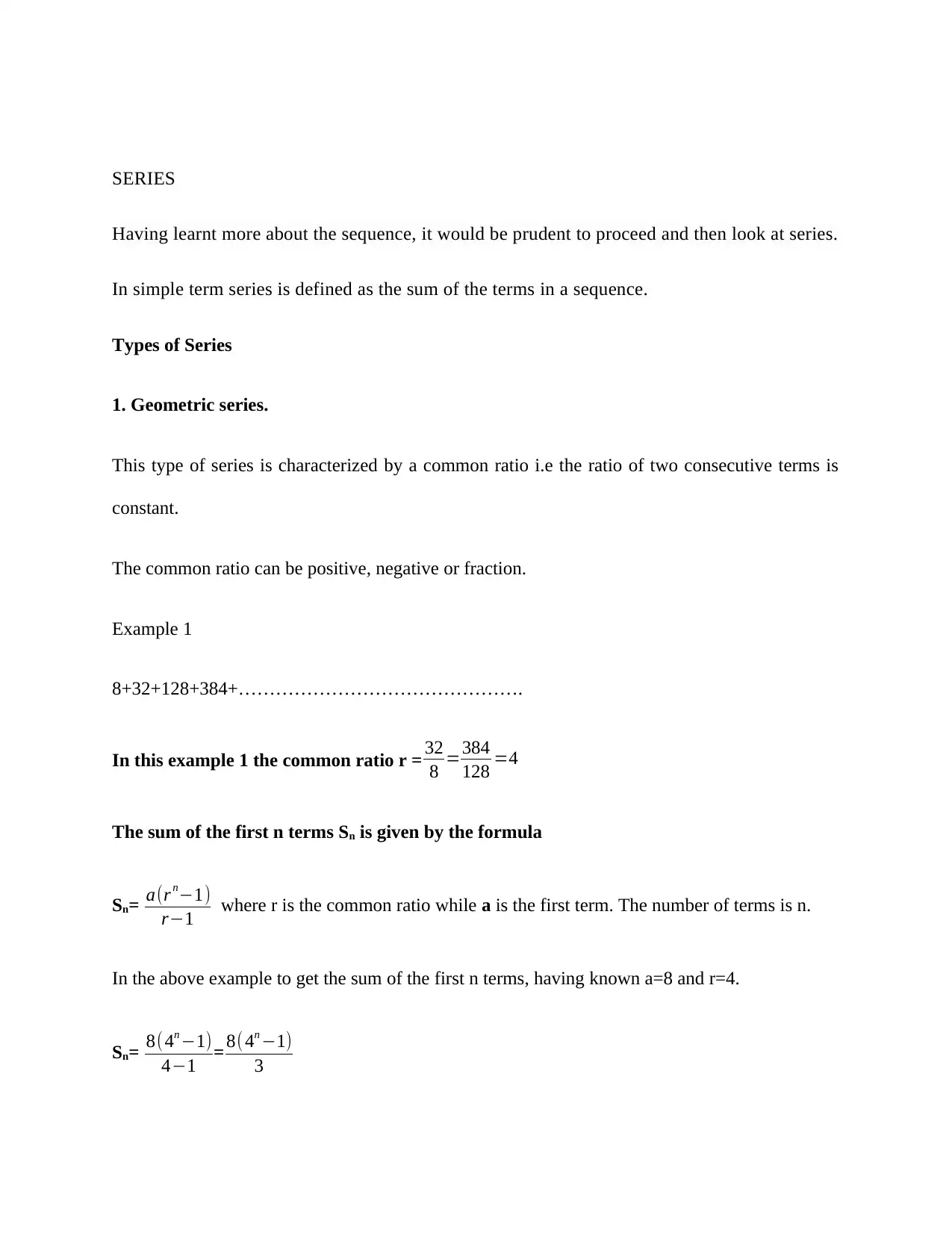
SERIES
Having learnt more about the sequence, it would be prudent to proceed and then look at series.
In simple term series is defined as the sum of the terms in a sequence.
Types of Series
1. Geometric series.
This type of series is characterized by a common ratio i.e the ratio of two consecutive terms is
constant.
The common ratio can be positive, negative or fraction.
Example 1
8+32+128+384+……………………………………….
In this example 1 the common ratio r = 32
8 =384
128 =4
The sum of the first n terms Sn is given by the formula
Sn= a(r n−1)
r−1 where r is the common ratio while a is the first term. The number of terms is n.
In the above example to get the sum of the first n terms, having known a=8 and r=4.
Sn= 8(4n −1)
4−1 = 8( 4n −1)
3
Having learnt more about the sequence, it would be prudent to proceed and then look at series.
In simple term series is defined as the sum of the terms in a sequence.
Types of Series
1. Geometric series.
This type of series is characterized by a common ratio i.e the ratio of two consecutive terms is
constant.
The common ratio can be positive, negative or fraction.
Example 1
8+32+128+384+……………………………………….
In this example 1 the common ratio r = 32
8 =384
128 =4
The sum of the first n terms Sn is given by the formula
Sn= a(r n−1)
r−1 where r is the common ratio while a is the first term. The number of terms is n.
In the above example to get the sum of the first n terms, having known a=8 and r=4.
Sn= 8(4n −1)
4−1 = 8( 4n −1)
3
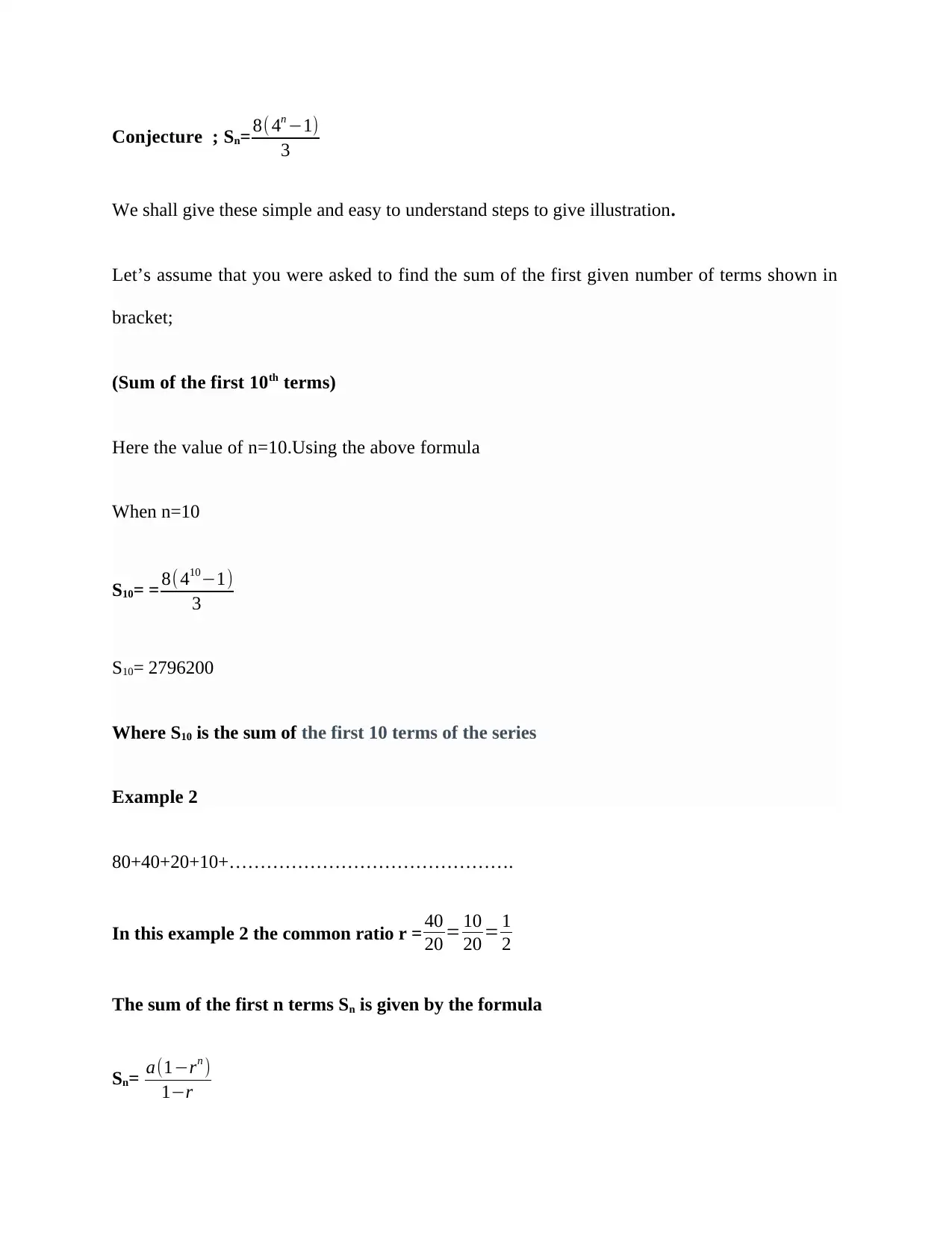
Conjecture ; Sn= 8( 4n −1)
3
We shall give these simple and easy to understand steps to give illustration.
Let’s assume that you were asked to find the sum of the first given number of terms shown in
bracket;
(Sum of the first 10th terms)
Here the value of n=10.Using the above formula
When n=10
S10= = 8( 410−1)
3
S10= 2796200
Where S10 is the sum of the first 10 terms of the series
Example 2
80+40+20+10+……………………………………….
In this example 2 the common ratio r = 40
20 = 10
20 = 1
2
The sum of the first n terms Sn is given by the formula
Sn= a(1−rn )
1−r
3
We shall give these simple and easy to understand steps to give illustration.
Let’s assume that you were asked to find the sum of the first given number of terms shown in
bracket;
(Sum of the first 10th terms)
Here the value of n=10.Using the above formula
When n=10
S10= = 8( 410−1)
3
S10= 2796200
Where S10 is the sum of the first 10 terms of the series
Example 2
80+40+20+10+……………………………………….
In this example 2 the common ratio r = 40
20 = 10
20 = 1
2
The sum of the first n terms Sn is given by the formula
Sn= a(1−rn )
1−r
Paraphrase This Document
Need a fresh take? Get an instant paraphrase of this document with our AI Paraphraser
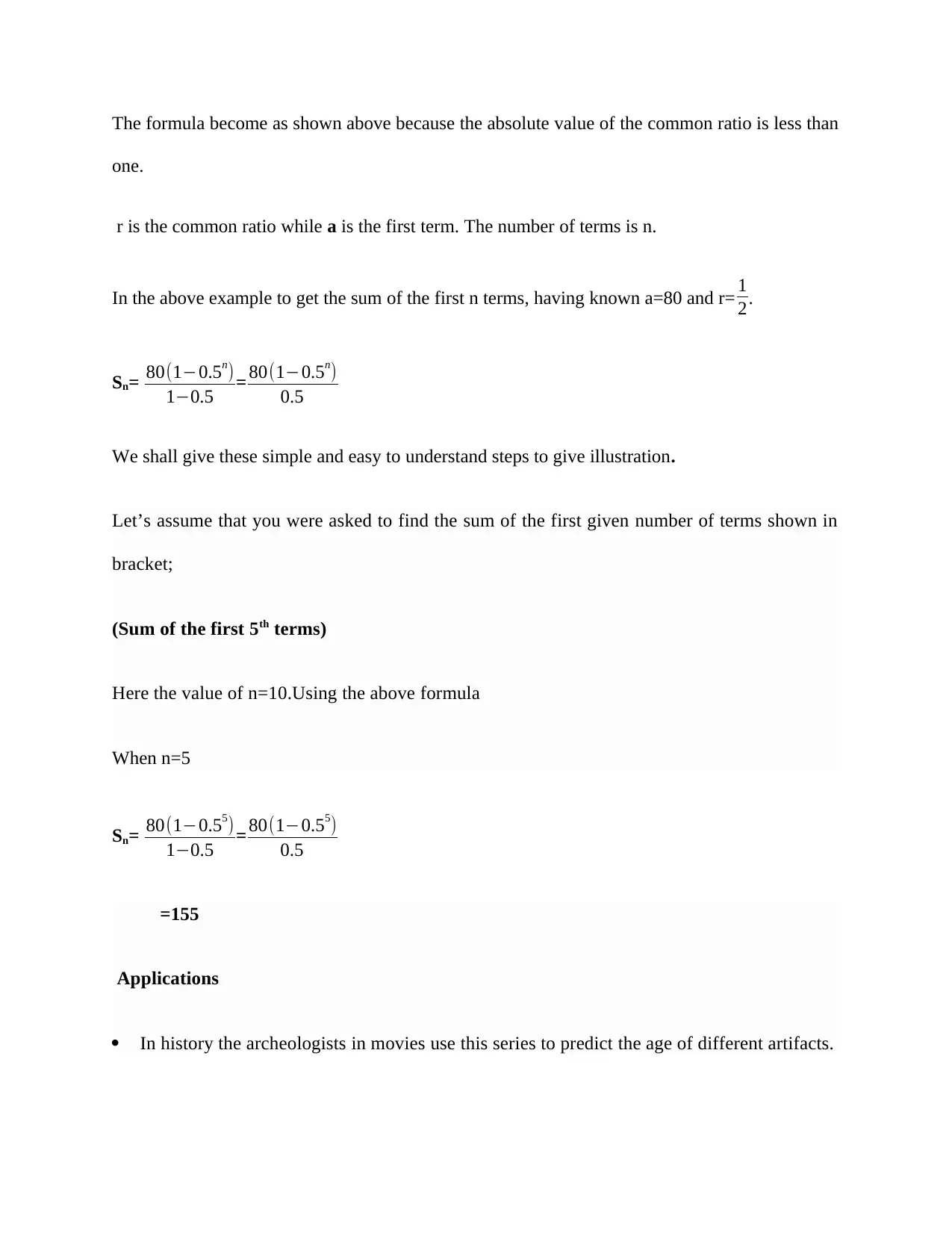
The formula become as shown above because the absolute value of the common ratio is less than
one.
r is the common ratio while a is the first term. The number of terms is n.
In the above example to get the sum of the first n terms, having known a=80 and r= 1
2.
Sn= 80(1−0.5n)
1−0.5 = 80(1−0.5n)
0.5
We shall give these simple and easy to understand steps to give illustration.
Let’s assume that you were asked to find the sum of the first given number of terms shown in
bracket;
(Sum of the first 5th terms)
Here the value of n=10.Using the above formula
When n=5
Sn= 80(1−0.55)
1−0.5 = 80(1−0.55)
0.5
=155
Applications
In history the archeologists in movies use this series to predict the age of different artifacts.
one.
r is the common ratio while a is the first term. The number of terms is n.
In the above example to get the sum of the first n terms, having known a=80 and r= 1
2.
Sn= 80(1−0.5n)
1−0.5 = 80(1−0.5n)
0.5
We shall give these simple and easy to understand steps to give illustration.
Let’s assume that you were asked to find the sum of the first given number of terms shown in
bracket;
(Sum of the first 5th terms)
Here the value of n=10.Using the above formula
When n=5
Sn= 80(1−0.55)
1−0.5 = 80(1−0.55)
0.5
=155
Applications
In history the archeologists in movies use this series to predict the age of different artifacts.
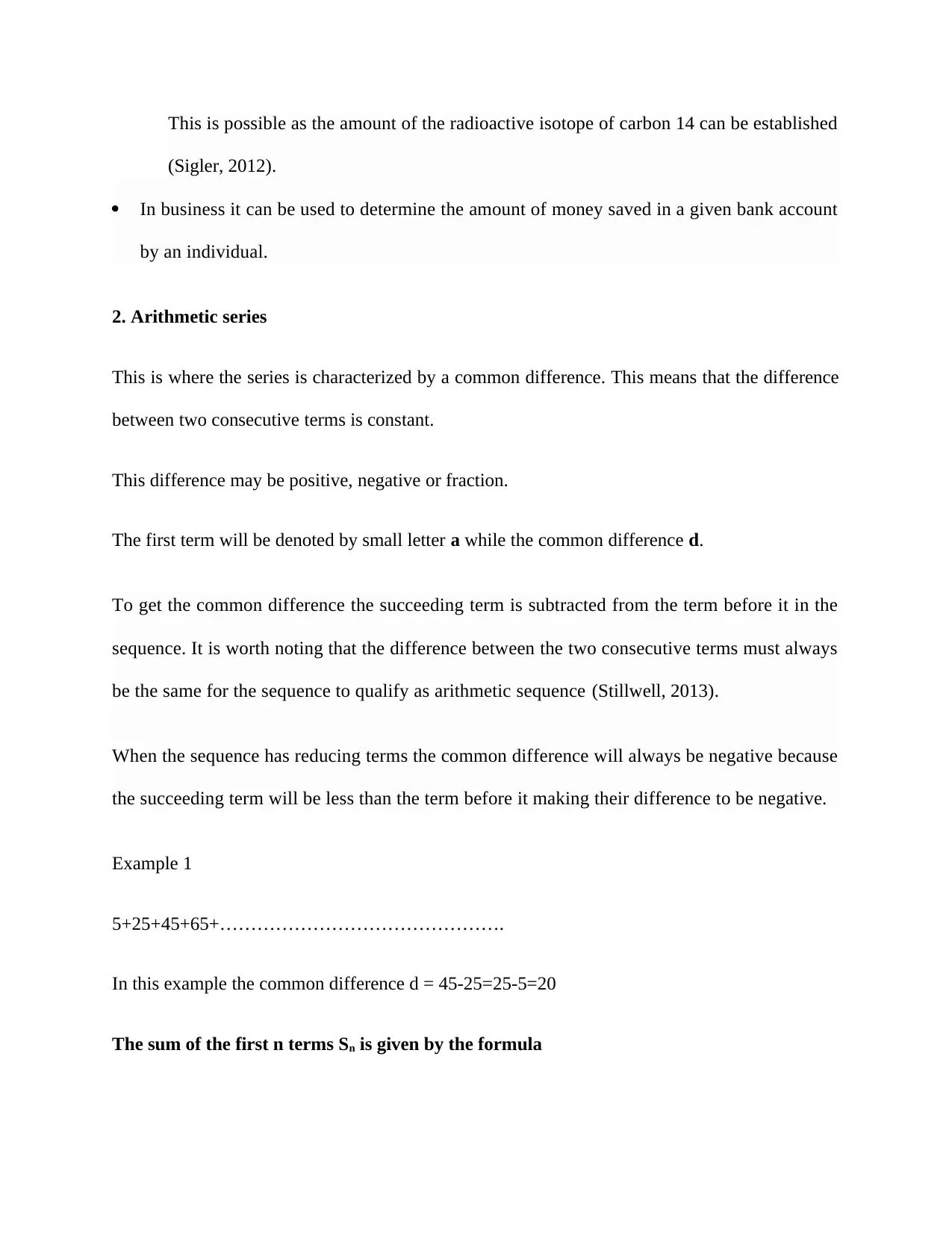
This is possible as the amount of the radioactive isotope of carbon 14 can be established
(Sigler, 2012).
In business it can be used to determine the amount of money saved in a given bank account
by an individual.
2. Arithmetic series
This is where the series is characterized by a common difference. This means that the difference
between two consecutive terms is constant.
This difference may be positive, negative or fraction.
The first term will be denoted by small letter a while the common difference d.
To get the common difference the succeeding term is subtracted from the term before it in the
sequence. It is worth noting that the difference between the two consecutive terms must always
be the same for the sequence to qualify as arithmetic sequence (Stillwell, 2013).
When the sequence has reducing terms the common difference will always be negative because
the succeeding term will be less than the term before it making their difference to be negative.
Example 1
5+25+45+65+……………………………………….
In this example the common difference d = 45-25=25-5=20
The sum of the first n terms Sn is given by the formula
(Sigler, 2012).
In business it can be used to determine the amount of money saved in a given bank account
by an individual.
2. Arithmetic series
This is where the series is characterized by a common difference. This means that the difference
between two consecutive terms is constant.
This difference may be positive, negative or fraction.
The first term will be denoted by small letter a while the common difference d.
To get the common difference the succeeding term is subtracted from the term before it in the
sequence. It is worth noting that the difference between the two consecutive terms must always
be the same for the sequence to qualify as arithmetic sequence (Stillwell, 2013).
When the sequence has reducing terms the common difference will always be negative because
the succeeding term will be less than the term before it making their difference to be negative.
Example 1
5+25+45+65+……………………………………….
In this example the common difference d = 45-25=25-5=20
The sum of the first n terms Sn is given by the formula
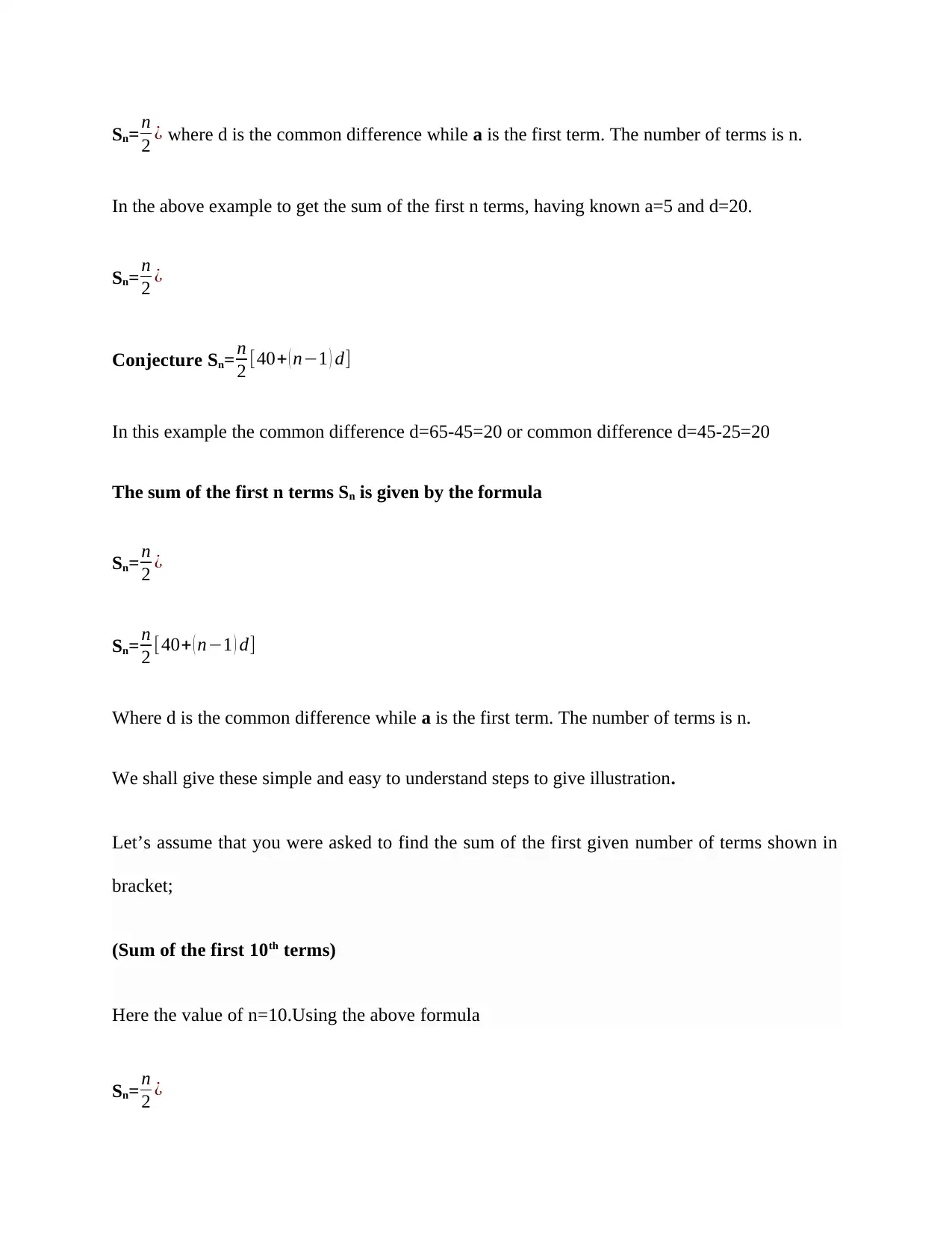
Sn= n
2 ¿ where d is the common difference while a is the first term. The number of terms is n.
In the above example to get the sum of the first n terms, having known a=5 and d=20.
Sn= n
2 ¿
Conjecture Sn= n
2 [40+ ( n−1 ) d]
In this example the common difference d=65-45=20 or common difference d=45-25=20
The sum of the first n terms Sn is given by the formula
Sn= n
2 ¿
Sn= n
2 [40+ ( n−1 ) d]
Where d is the common difference while a is the first term. The number of terms is n.
We shall give these simple and easy to understand steps to give illustration.
Let’s assume that you were asked to find the sum of the first given number of terms shown in
bracket;
(Sum of the first 10th terms)
Here the value of n=10.Using the above formula
Sn= n
2 ¿
2 ¿ where d is the common difference while a is the first term. The number of terms is n.
In the above example to get the sum of the first n terms, having known a=5 and d=20.
Sn= n
2 ¿
Conjecture Sn= n
2 [40+ ( n−1 ) d]
In this example the common difference d=65-45=20 or common difference d=45-25=20
The sum of the first n terms Sn is given by the formula
Sn= n
2 ¿
Sn= n
2 [40+ ( n−1 ) d]
Where d is the common difference while a is the first term. The number of terms is n.
We shall give these simple and easy to understand steps to give illustration.
Let’s assume that you were asked to find the sum of the first given number of terms shown in
bracket;
(Sum of the first 10th terms)
Here the value of n=10.Using the above formula
Sn= n
2 ¿
Secure Best Marks with AI Grader
Need help grading? Try our AI Grader for instant feedback on your assignments.
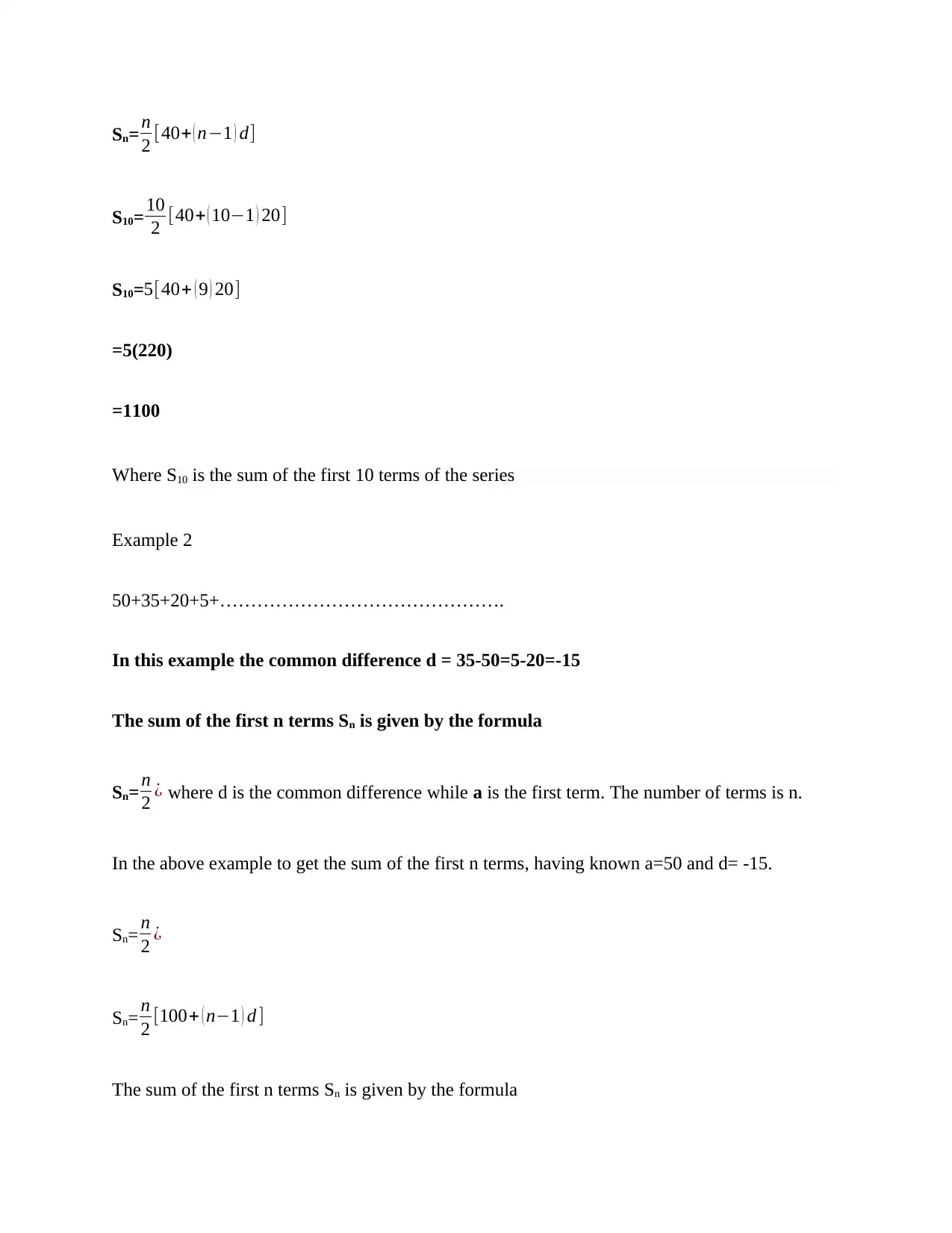
Sn= n
2 [40+ ( n−1 ) d]
S10= 10
2 [40+ ( 10−1 ) 20]
S10=5[40+ ( 9 ) 20]
=5(220)
=1100
Where S10 is the sum of the first 10 terms of the series
Example 2
50+35+20+5+……………………………………….
In this example the common difference d = 35-50=5-20=-15
The sum of the first n terms Sn is given by the formula
Sn= n
2 ¿ where d is the common difference while a is the first term. The number of terms is n.
In the above example to get the sum of the first n terms, having known a=50 and d= -15.
Sn= n
2 ¿
Sn= n
2 [100+ ( n−1 ) d ]
The sum of the first n terms Sn is given by the formula
2 [40+ ( n−1 ) d]
S10= 10
2 [40+ ( 10−1 ) 20]
S10=5[40+ ( 9 ) 20]
=5(220)
=1100
Where S10 is the sum of the first 10 terms of the series
Example 2
50+35+20+5+……………………………………….
In this example the common difference d = 35-50=5-20=-15
The sum of the first n terms Sn is given by the formula
Sn= n
2 ¿ where d is the common difference while a is the first term. The number of terms is n.
In the above example to get the sum of the first n terms, having known a=50 and d= -15.
Sn= n
2 ¿
Sn= n
2 [100+ ( n−1 ) d ]
The sum of the first n terms Sn is given by the formula
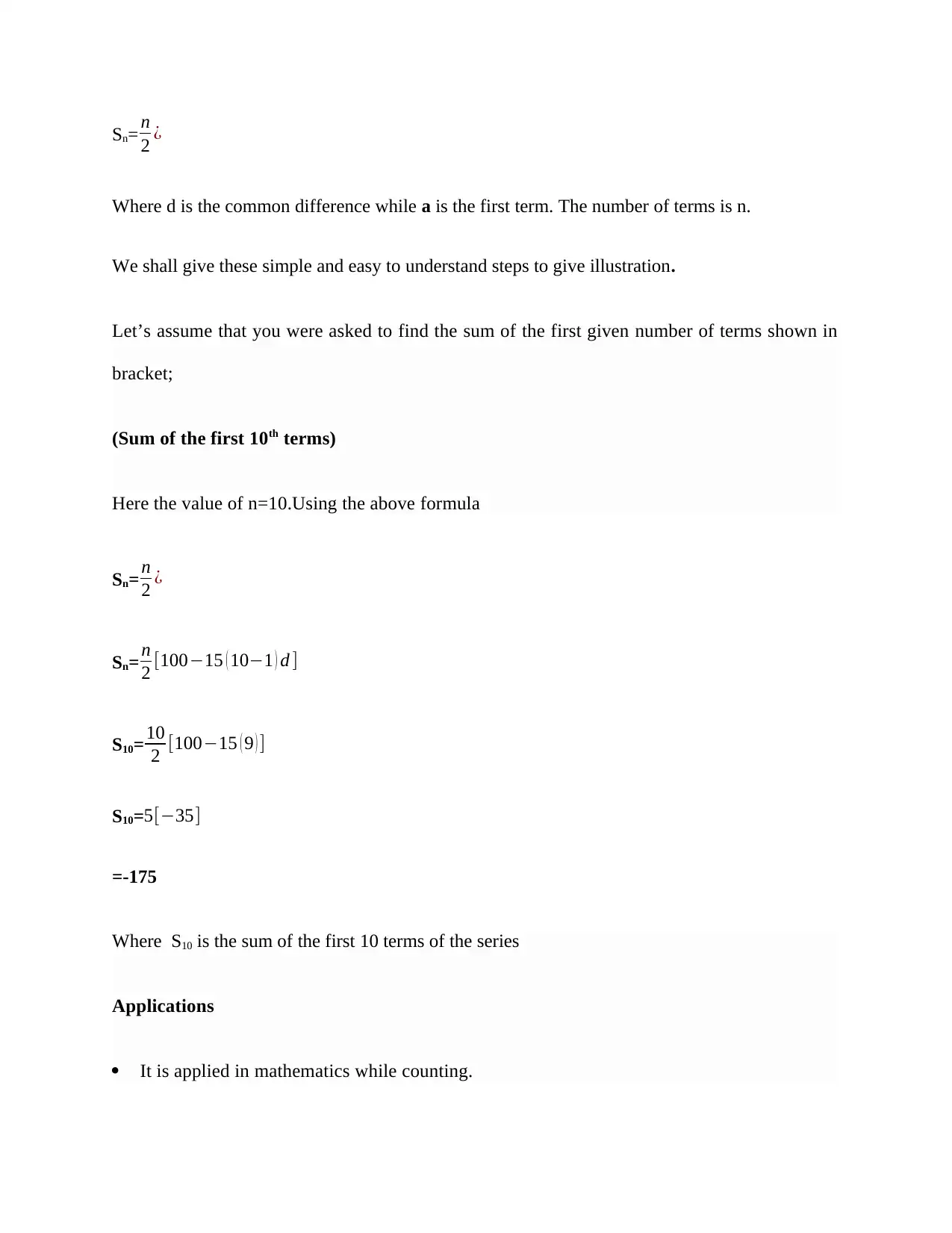
Sn= n
2 ¿
Where d is the common difference while a is the first term. The number of terms is n.
We shall give these simple and easy to understand steps to give illustration.
Let’s assume that you were asked to find the sum of the first given number of terms shown in
bracket;
(Sum of the first 10th terms)
Here the value of n=10.Using the above formula
Sn= n
2 ¿
Sn= n
2 [100−15 ( 10−1 ) d ]
S10= 10
2 [100−15 ( 9 ) ]
S10=5[−35]
=-175
Where S10 is the sum of the first 10 terms of the series
Applications
It is applied in mathematics while counting.
2 ¿
Where d is the common difference while a is the first term. The number of terms is n.
We shall give these simple and easy to understand steps to give illustration.
Let’s assume that you were asked to find the sum of the first given number of terms shown in
bracket;
(Sum of the first 10th terms)
Here the value of n=10.Using the above formula
Sn= n
2 ¿
Sn= n
2 [100−15 ( 10−1 ) d ]
S10= 10
2 [100−15 ( 9 ) ]
S10=5[−35]
=-175
Where S10 is the sum of the first 10 terms of the series
Applications
It is applied in mathematics while counting.
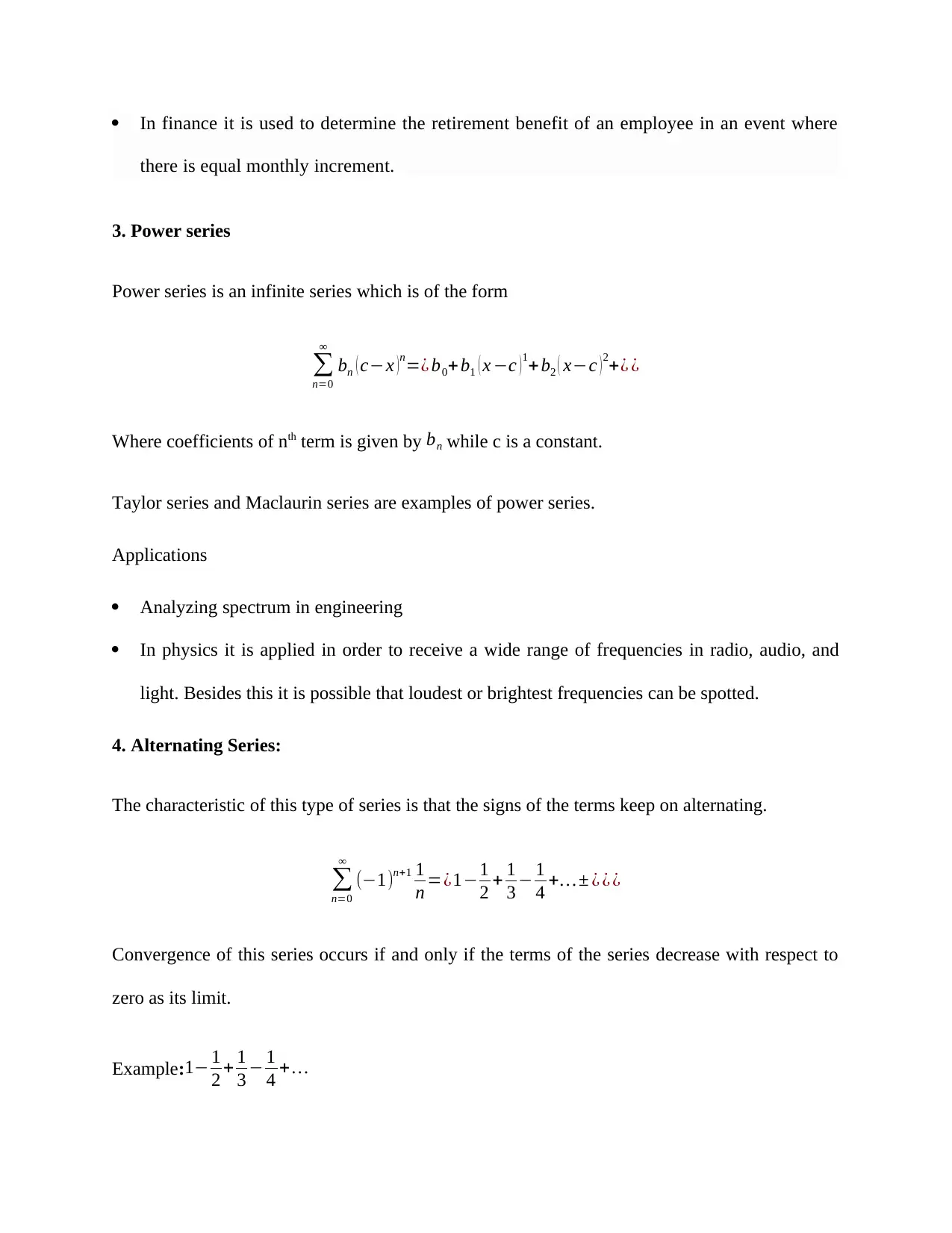
In finance it is used to determine the retirement benefit of an employee in an event where
there is equal monthly increment.
3. Power series
Power series is an infinite series which is of the form
∑
n=0
∞
bn ( c−x )n=¿ b0+ b1 ( x −c )1+ b2 ( x−c )2+¿ ¿
Where coefficients of nth term is given by bn while c is a constant.
Taylor series and Maclaurin series are examples of power series.
Applications
Analyzing spectrum in engineering
In physics it is applied in order to receive a wide range of frequencies in radio, audio, and
light. Besides this it is possible that loudest or brightest frequencies can be spotted.
4. Alternating Series:
The characteristic of this type of series is that the signs of the terms keep on alternating.
∑
n=0
∞
(−1)n+1 1
n =¿1−1
2 + 1
3 − 1
4 +… ± ¿ ¿ ¿
Convergence of this series occurs if and only if the terms of the series decrease with respect to
zero as its limit.
Example:1− 1
2 + 1
3 − 1
4 + …
there is equal monthly increment.
3. Power series
Power series is an infinite series which is of the form
∑
n=0
∞
bn ( c−x )n=¿ b0+ b1 ( x −c )1+ b2 ( x−c )2+¿ ¿
Where coefficients of nth term is given by bn while c is a constant.
Taylor series and Maclaurin series are examples of power series.
Applications
Analyzing spectrum in engineering
In physics it is applied in order to receive a wide range of frequencies in radio, audio, and
light. Besides this it is possible that loudest or brightest frequencies can be spotted.
4. Alternating Series:
The characteristic of this type of series is that the signs of the terms keep on alternating.
∑
n=0
∞
(−1)n+1 1
n =¿1−1
2 + 1
3 − 1
4 +… ± ¿ ¿ ¿
Convergence of this series occurs if and only if the terms of the series decrease with respect to
zero as its limit.
Example:1− 1
2 + 1
3 − 1
4 + …
Paraphrase This Document
Need a fresh take? Get an instant paraphrase of this document with our AI Paraphraser
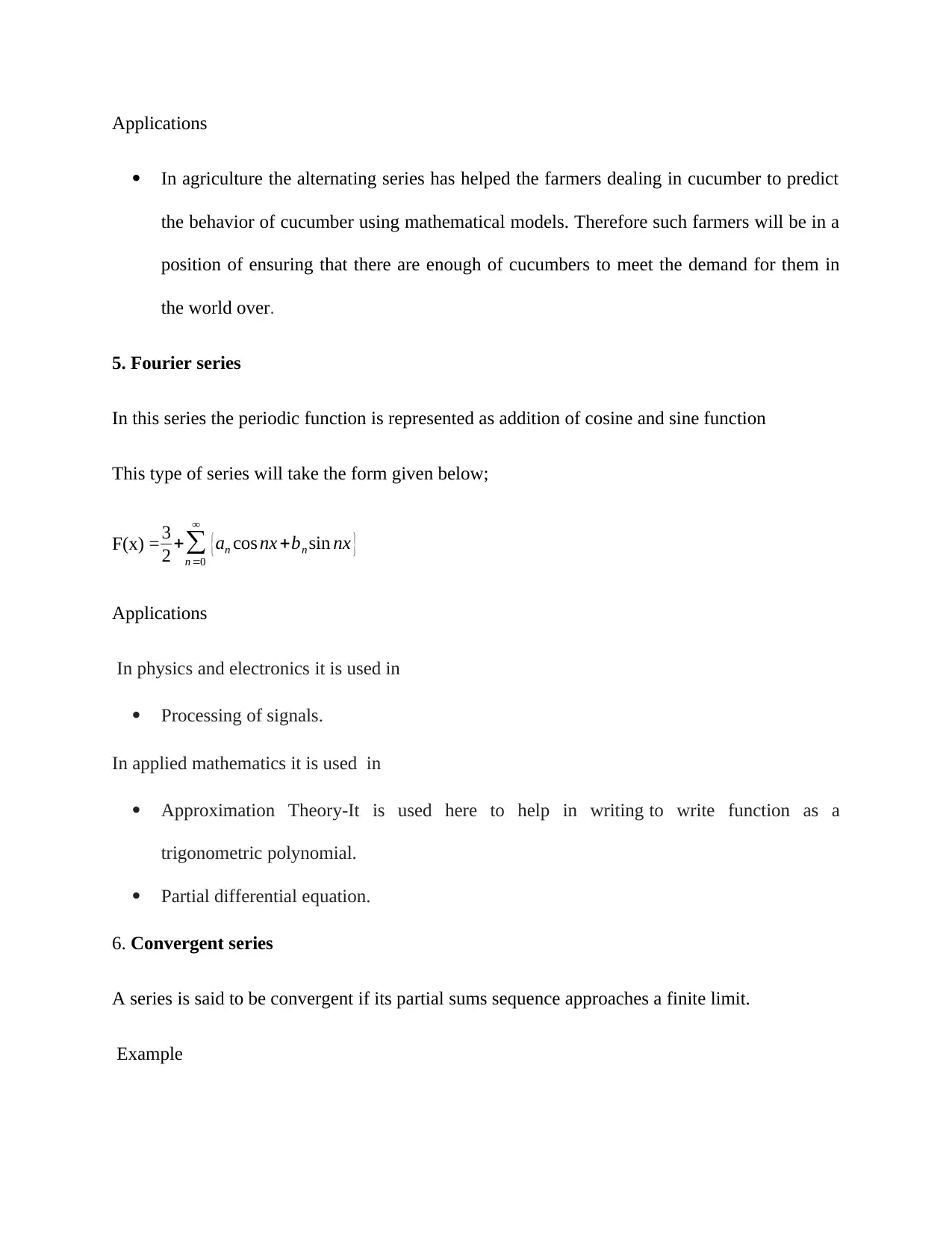
Applications
In agriculture the alternating series has helped the farmers dealing in cucumber to predict
the behavior of cucumber using mathematical models. Therefore such farmers will be in a
position of ensuring that there are enough of cucumbers to meet the demand for them in
the world over.
5. Fourier series
In this series the periodic function is represented as addition of cosine and sine function
This type of series will take the form given below;
F(x) = 3
2 +∑
n =0
∞
{an cos nx +bn sin nx }
Applications
In physics and electronics it is used in
Processing of signals.
In applied mathematics it is used in
Approximation Theory-It is used here to help in writing to write function as a
trigonometric polynomial.
Partial differential equation.
6. Convergent series
A series is said to be convergent if its partial sums sequence approaches a finite limit.
Example
In agriculture the alternating series has helped the farmers dealing in cucumber to predict
the behavior of cucumber using mathematical models. Therefore such farmers will be in a
position of ensuring that there are enough of cucumbers to meet the demand for them in
the world over.
5. Fourier series
In this series the periodic function is represented as addition of cosine and sine function
This type of series will take the form given below;
F(x) = 3
2 +∑
n =0
∞
{an cos nx +bn sin nx }
Applications
In physics and electronics it is used in
Processing of signals.
In applied mathematics it is used in
Approximation Theory-It is used here to help in writing to write function as a
trigonometric polynomial.
Partial differential equation.
6. Convergent series
A series is said to be convergent if its partial sums sequence approaches a finite limit.
Example
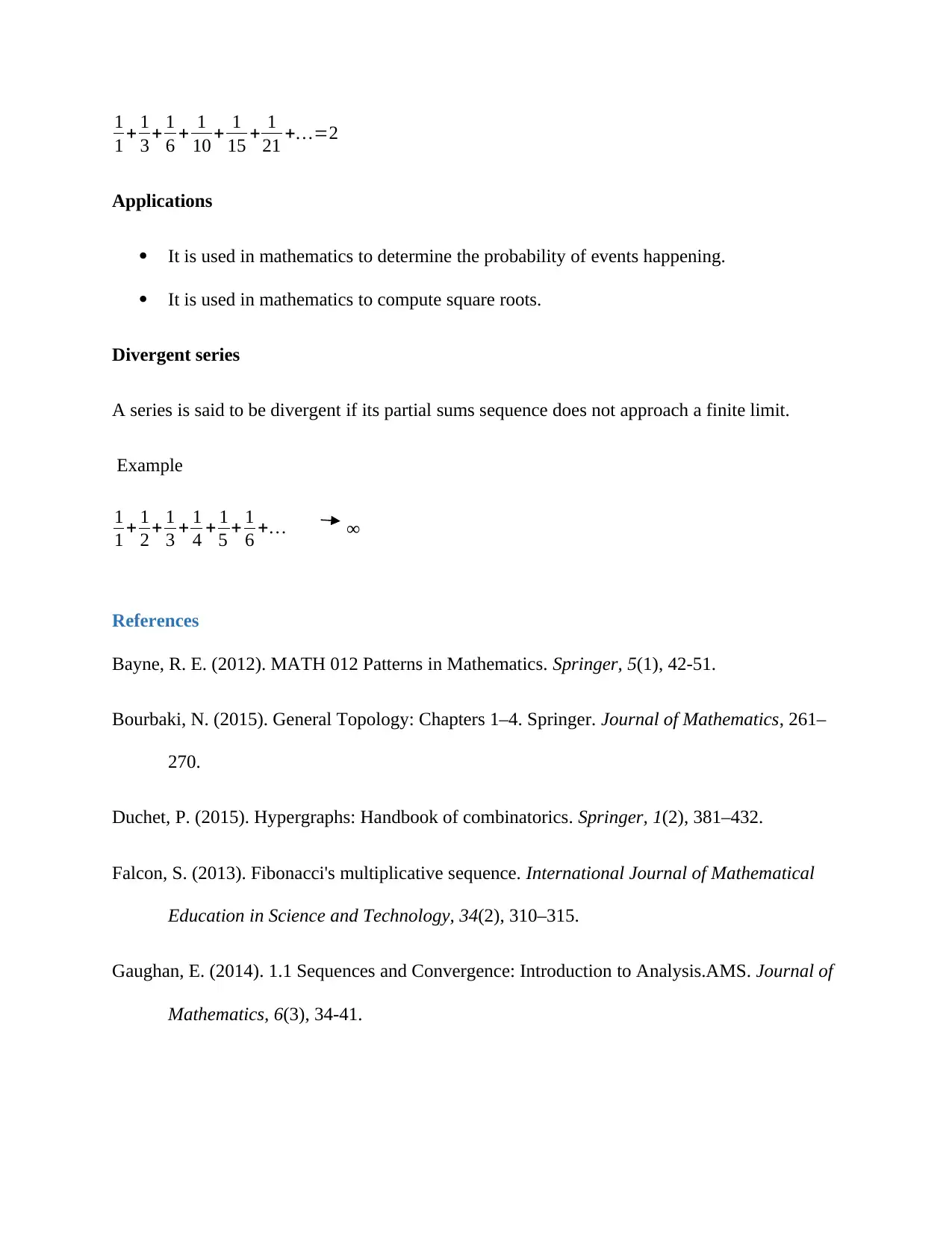
1
1 + 1
3 + 1
6 + 1
10 + 1
15 + 1
21 +…=2
Applications
It is used in mathematics to determine the probability of events happening.
It is used in mathematics to compute square roots.
Divergent series
A series is said to be divergent if its partial sums sequence does not approach a finite limit.
Example
1
1 + 1
2 + 1
3 + 1
4 + 1
5 + 1
6 +… ∞
References
Bayne, R. E. (2012). MATH 012 Patterns in Mathematics. Springer, 5(1), 42-51.
Bourbaki, N. (2015). General Topology: Chapters 1–4. Springer. Journal of Mathematics, 261–
270.
Duchet, P. (2015). Hypergraphs: Handbook of combinatorics. Springer, 1(2), 381–432.
Falcon, S. (2013). Fibonacci's multiplicative sequence. International Journal of Mathematical
Education in Science and Technology, 34(2), 310–315.
Gaughan, E. (2014). 1.1 Sequences and Convergence: Introduction to Analysis.AMS. Journal of
Mathematics, 6(3), 34-41.
1 + 1
3 + 1
6 + 1
10 + 1
15 + 1
21 +…=2
Applications
It is used in mathematics to determine the probability of events happening.
It is used in mathematics to compute square roots.
Divergent series
A series is said to be divergent if its partial sums sequence does not approach a finite limit.
Example
1
1 + 1
2 + 1
3 + 1
4 + 1
5 + 1
6 +… ∞
References
Bayne, R. E. (2012). MATH 012 Patterns in Mathematics. Springer, 5(1), 42-51.
Bourbaki, N. (2015). General Topology: Chapters 1–4. Springer. Journal of Mathematics, 261–
270.
Duchet, P. (2015). Hypergraphs: Handbook of combinatorics. Springer, 1(2), 381–432.
Falcon, S. (2013). Fibonacci's multiplicative sequence. International Journal of Mathematical
Education in Science and Technology, 34(2), 310–315.
Gaughan, E. (2014). 1.1 Sequences and Convergence: Introduction to Analysis.AMS. Journal of
Mathematics, 6(3), 34-41.
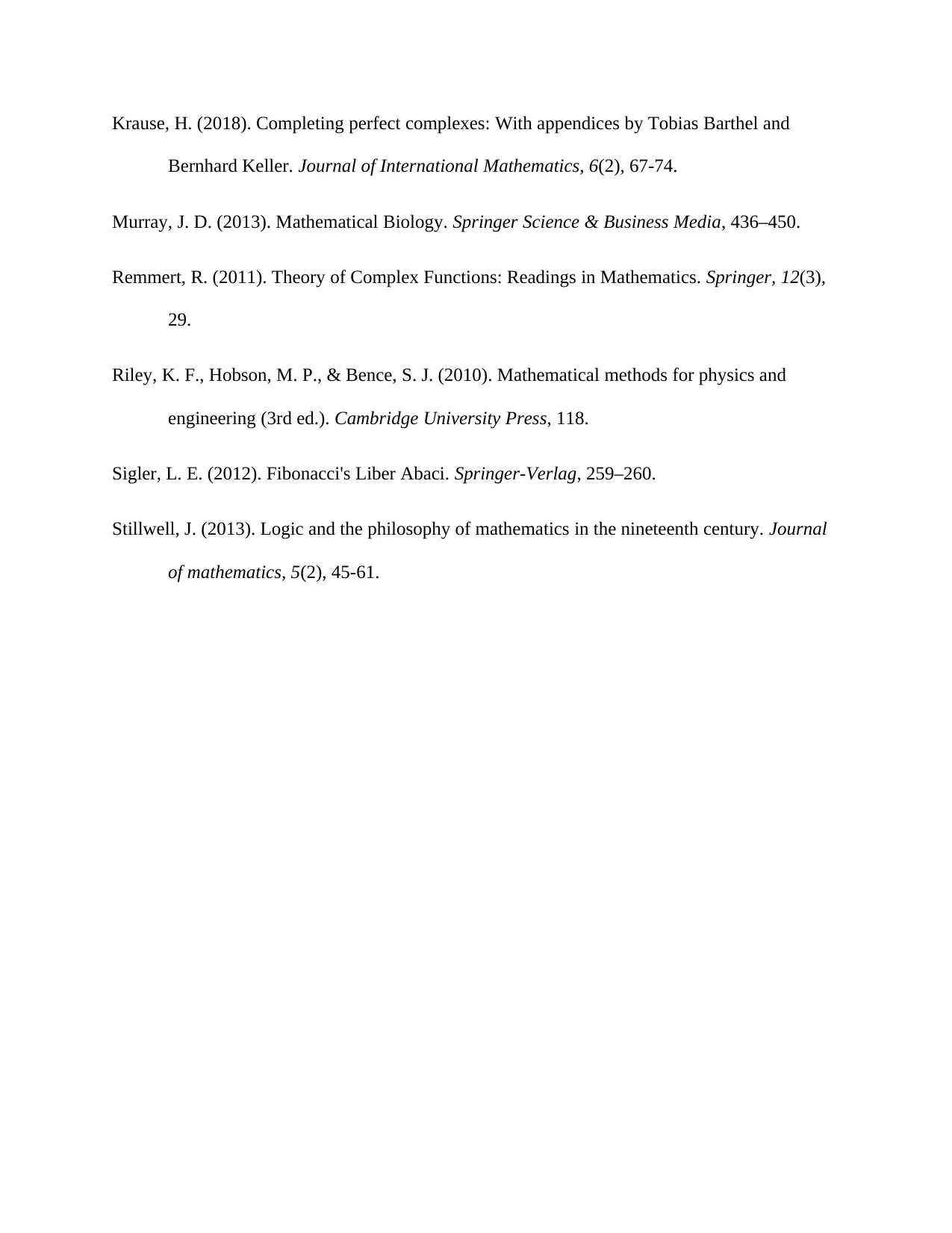
Krause, H. (2018). Completing perfect complexes: With appendices by Tobias Barthel and
Bernhard Keller. Journal of International Mathematics, 6(2), 67-74.
Murray, J. D. (2013). Mathematical Biology. Springer Science & Business Media, 436–450.
Remmert, R. (2011). Theory of Complex Functions: Readings in Mathematics. Springer, 12(3),
29.
Riley, K. F., Hobson, M. P., & Bence, S. J. (2010). Mathematical methods for physics and
engineering (3rd ed.). Cambridge University Press, 118.
Sigler, L. E. (2012). Fibonacci's Liber Abaci. Springer-Verlag, 259–260.
Stillwell, J. (2013). Logic and the philosophy of mathematics in the nineteenth century. Journal
of mathematics, 5(2), 45-61.
Bernhard Keller. Journal of International Mathematics, 6(2), 67-74.
Murray, J. D. (2013). Mathematical Biology. Springer Science & Business Media, 436–450.
Remmert, R. (2011). Theory of Complex Functions: Readings in Mathematics. Springer, 12(3),
29.
Riley, K. F., Hobson, M. P., & Bence, S. J. (2010). Mathematical methods for physics and
engineering (3rd ed.). Cambridge University Press, 118.
Sigler, L. E. (2012). Fibonacci's Liber Abaci. Springer-Verlag, 259–260.
Stillwell, J. (2013). Logic and the philosophy of mathematics in the nineteenth century. Journal
of mathematics, 5(2), 45-61.
1 out of 22
Related Documents
Your All-in-One AI-Powered Toolkit for Academic Success.
+13062052269
info@desklib.com
Available 24*7 on WhatsApp / Email
![[object Object]](/_next/static/media/star-bottom.7253800d.svg)
Unlock your academic potential
© 2024 | Zucol Services PVT LTD | All rights reserved.





